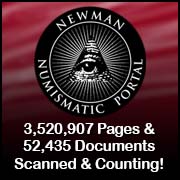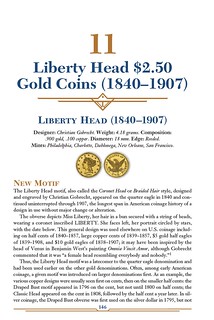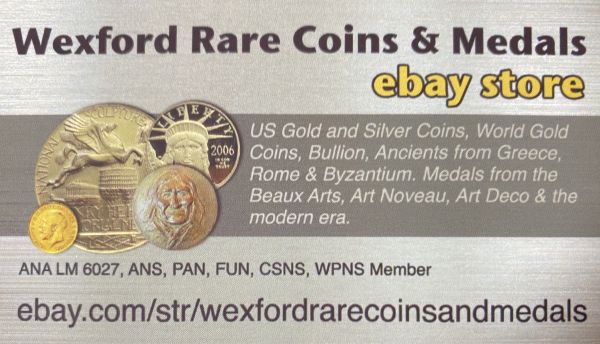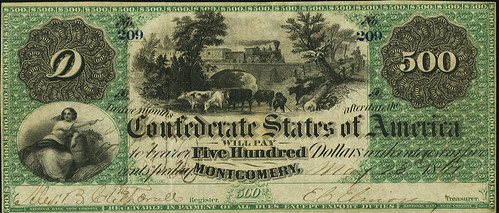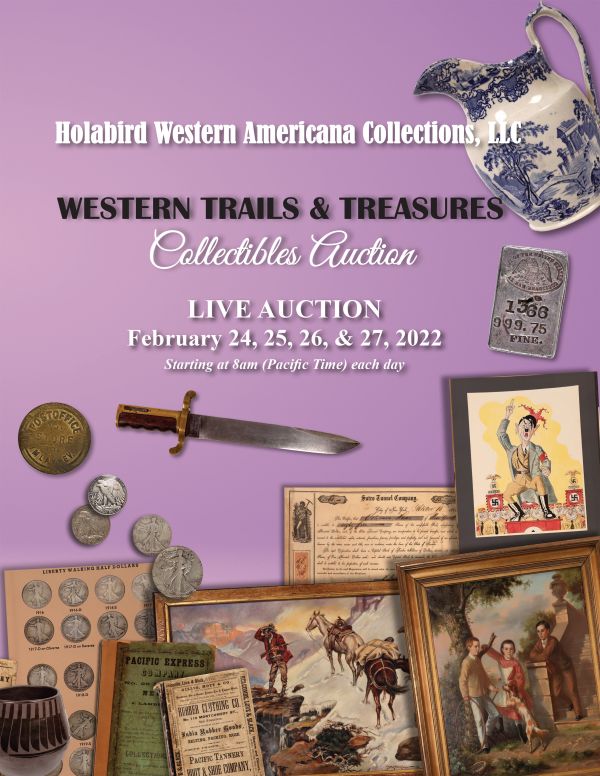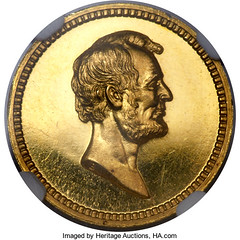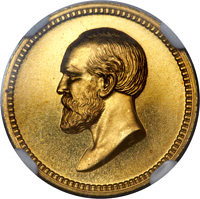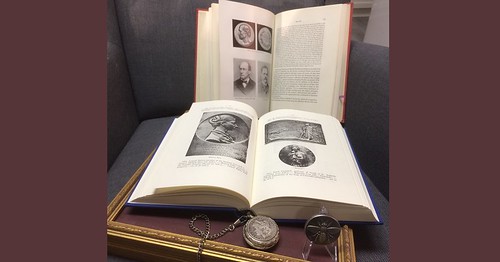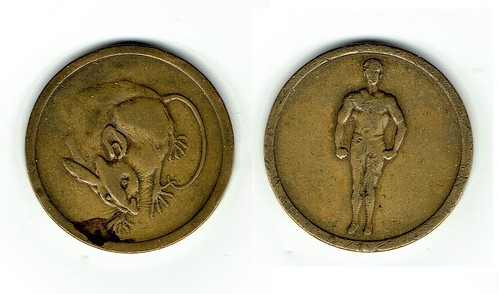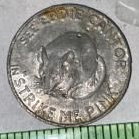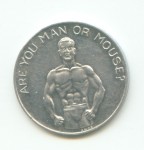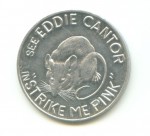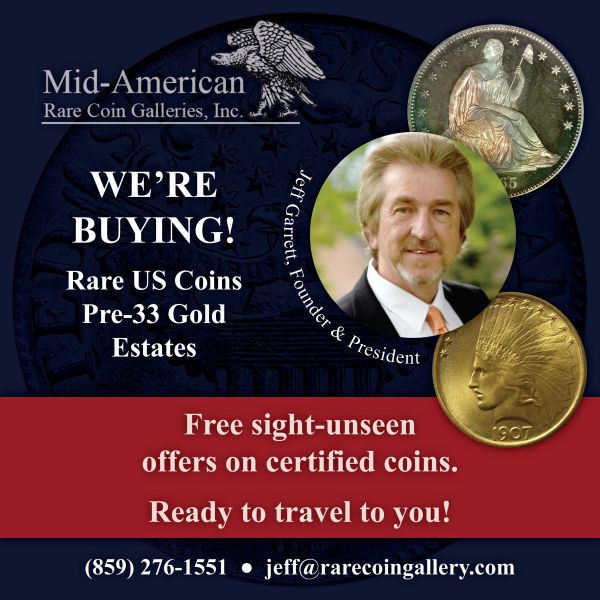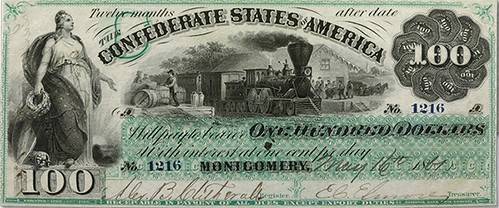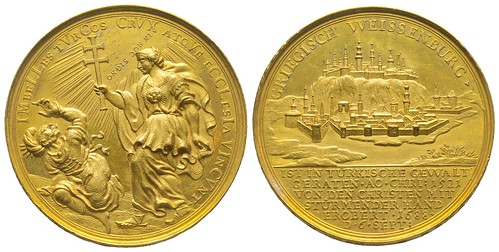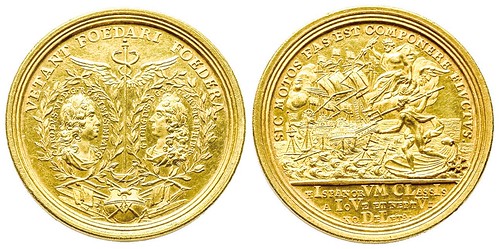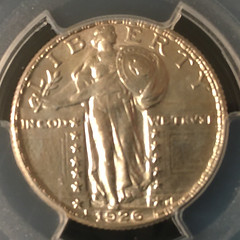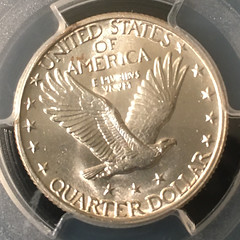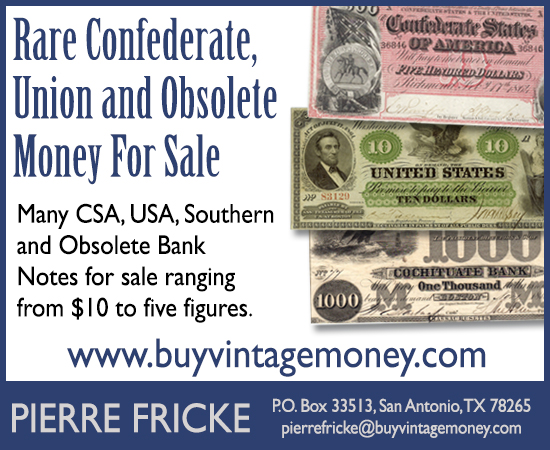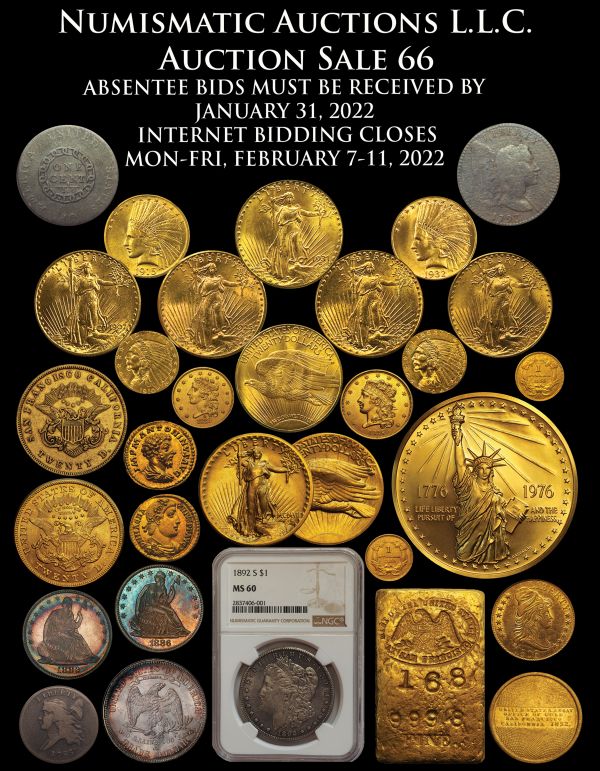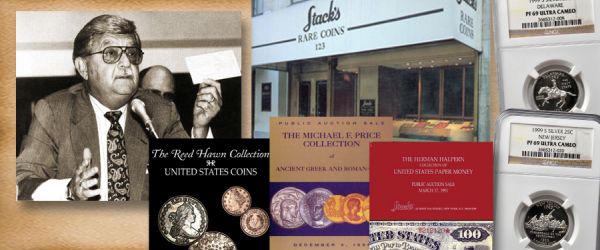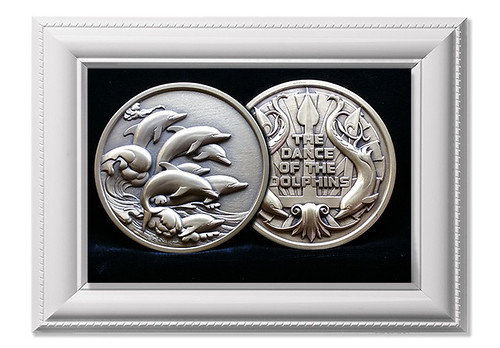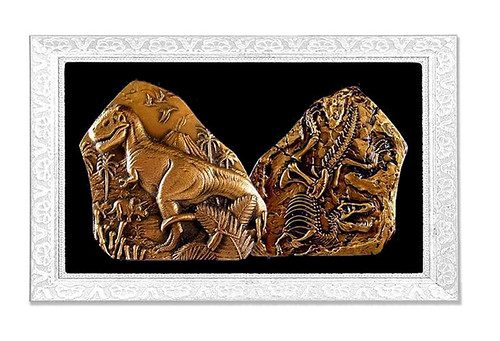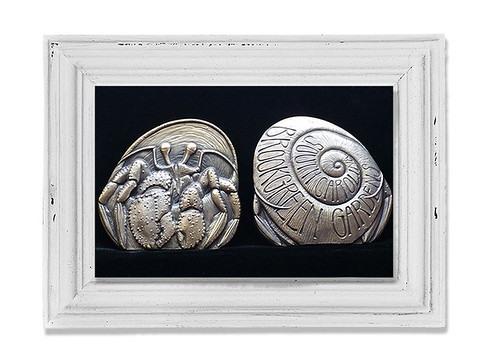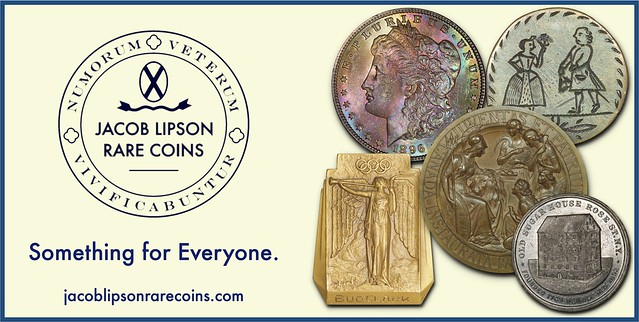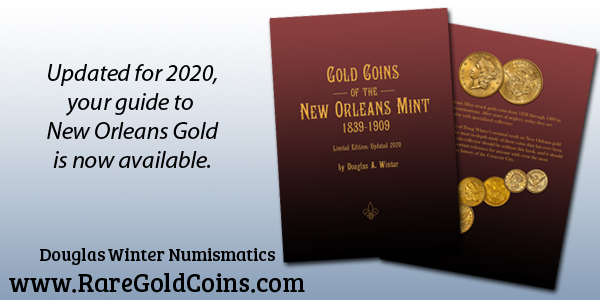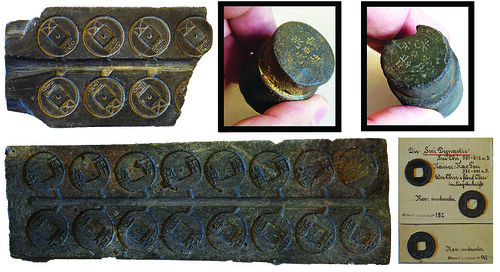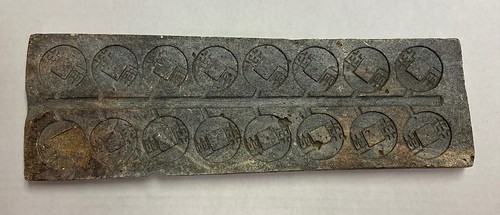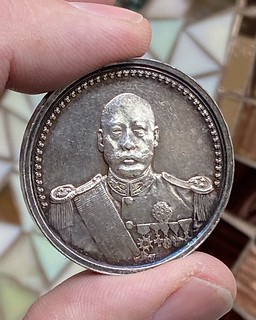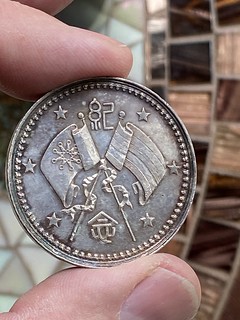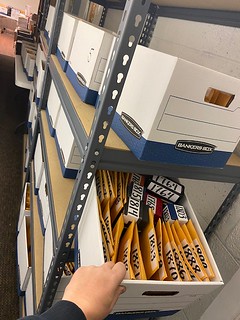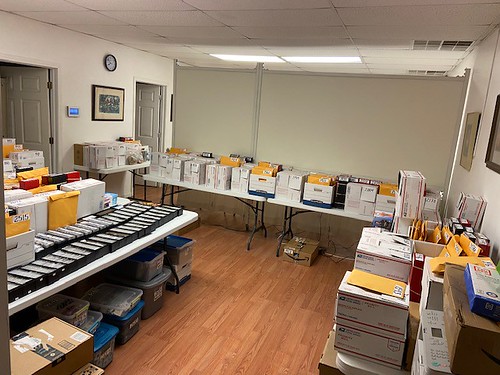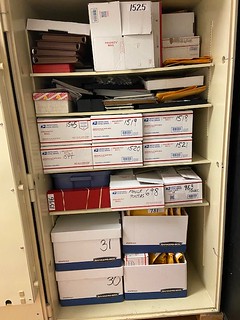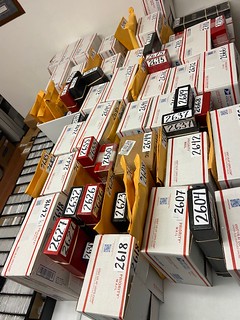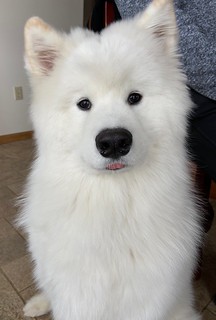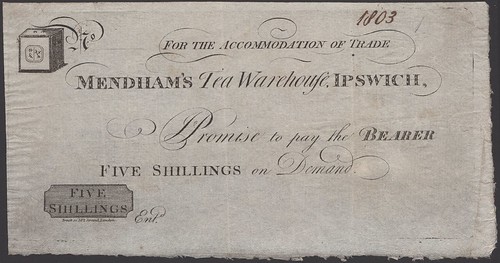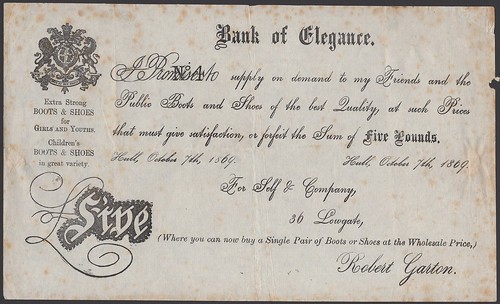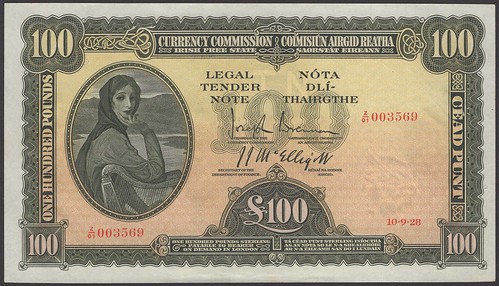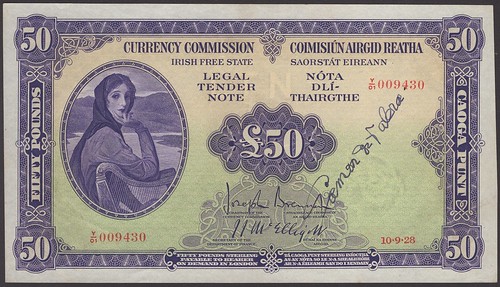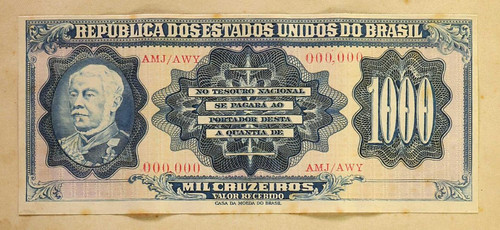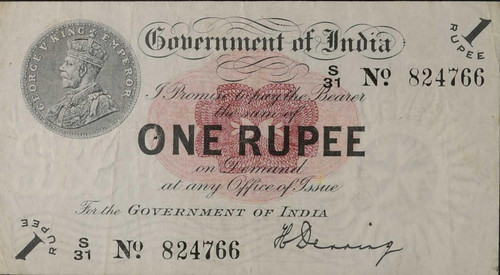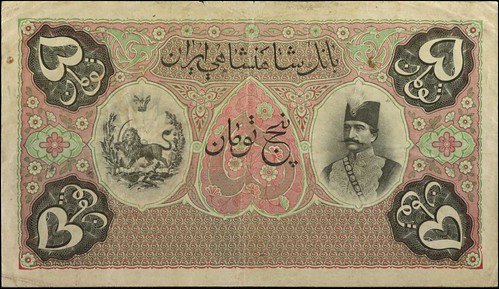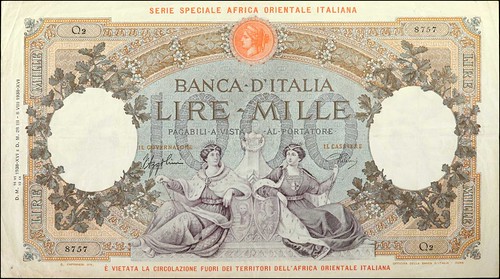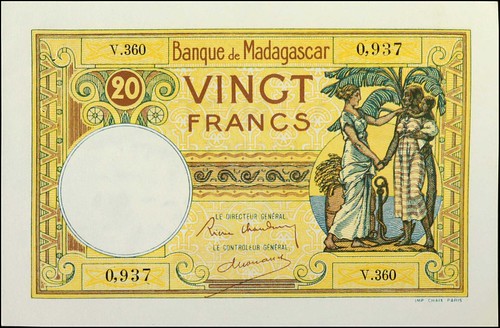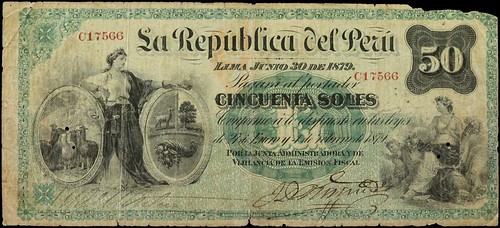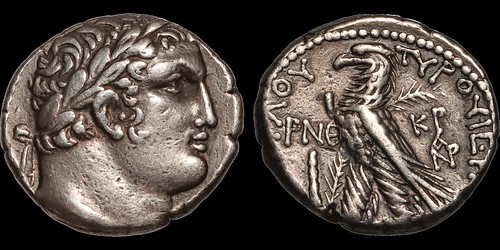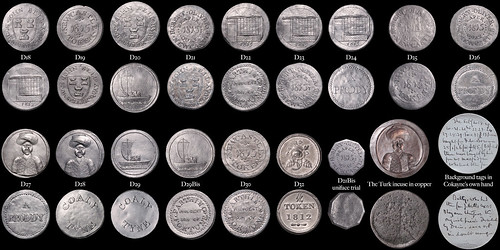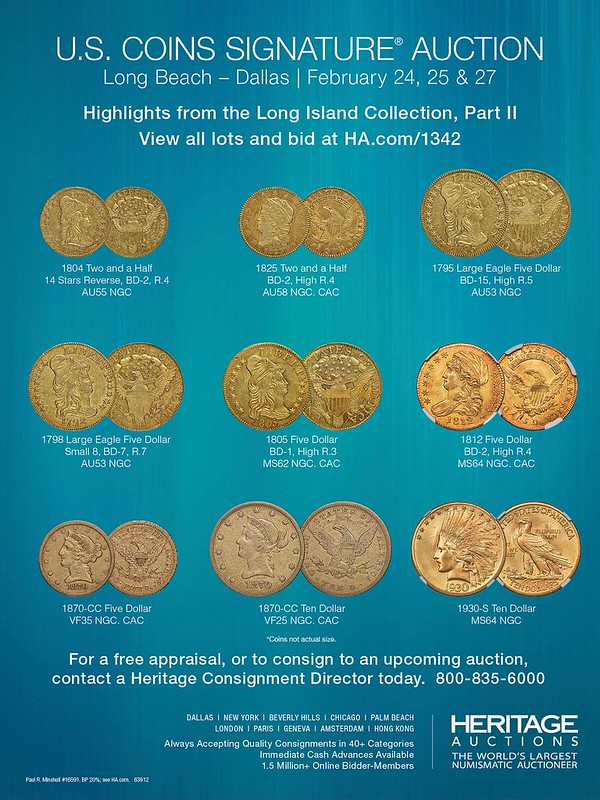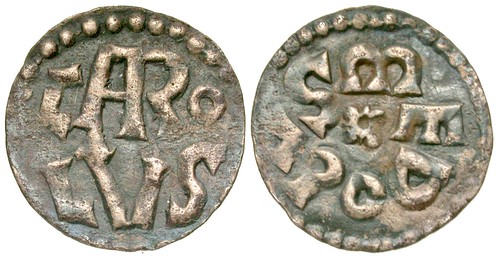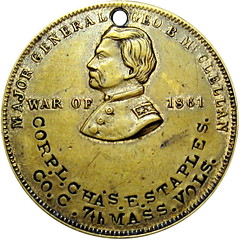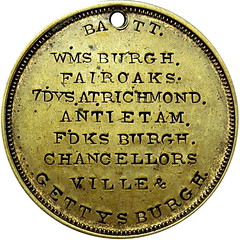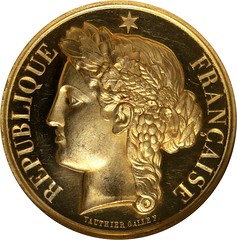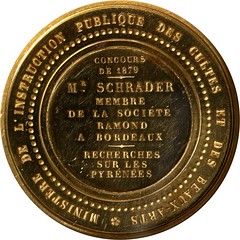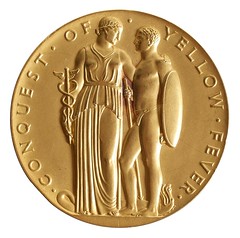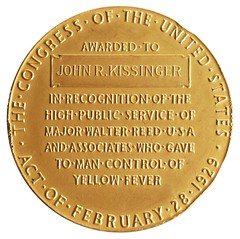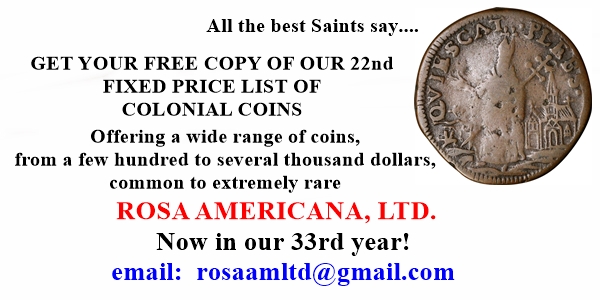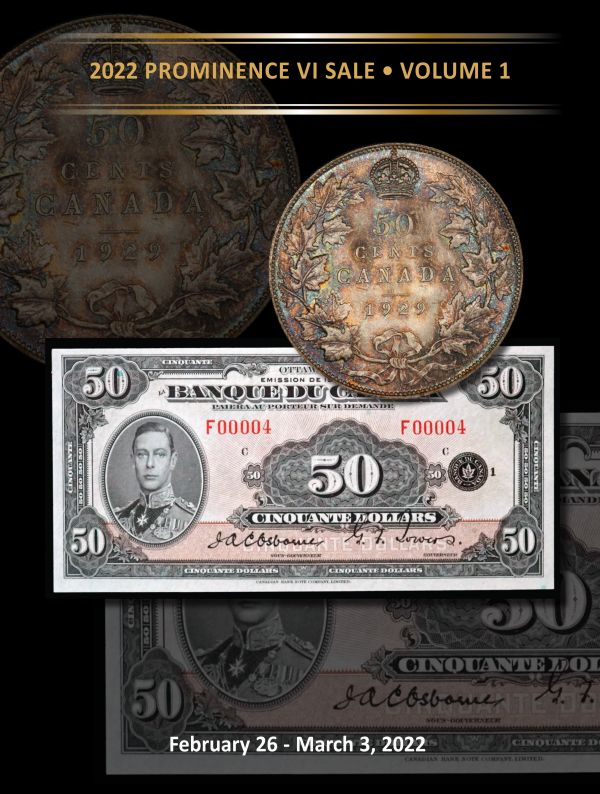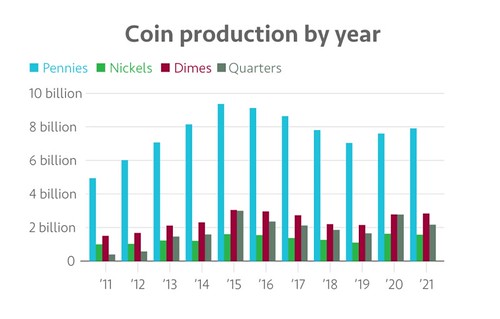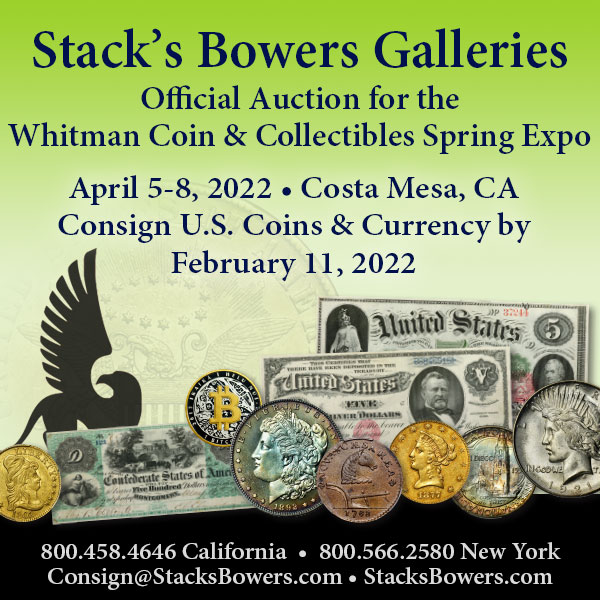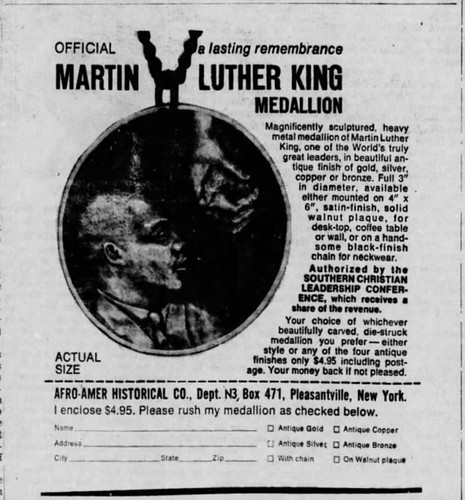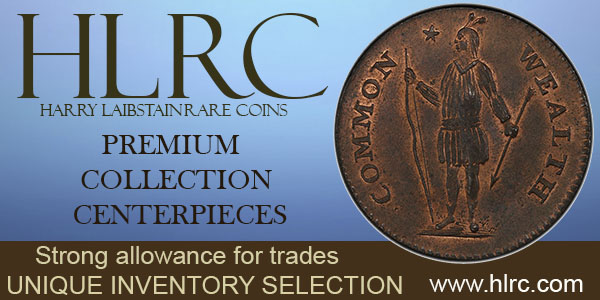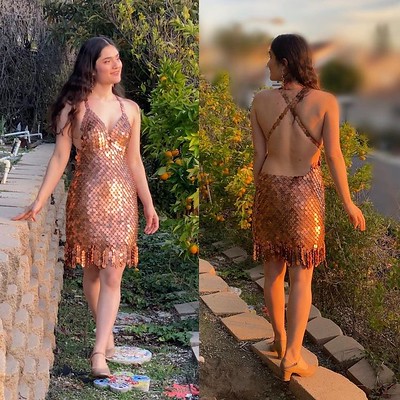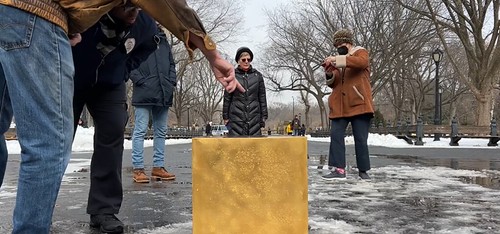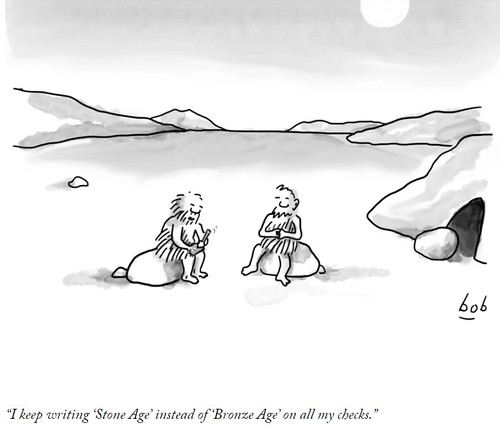
Visit our NBS Sponsors



About UsThe Numismatic Bibliomania Society is a non-profit association devoted to the study and enjoyment of numismatic literature. For more information please see our web site at coinbooks.org SubscriptionsThose wishing to become new E-Sylum subscribers (or wishing to Unsubscribe) can go to the following web page link MembershipThere is a membership application available on the web site Membership Application To join, print the application and return it with your check to the address printed on the application. Print/Digital membership is $40 to addresses in the U.S., and $60 elsewhere. A digital-only membership is available for $25. For those without web access, write to: Charles Heck, Treasurer AsylumFor Asylum mailing address changes and other membership questions, contact Chuck at this email address: treasurer@coinbooks.org SubmissionsTo submit items for publication in The E-Sylum, write to the Editor at this address: whomren@gmail.com BUY THE BOOK BEFORE THE COIN |
- WAYNE'S WORDS: THE E-SYLUM FEBRUARY 6, 2022
- IN APPRECIATION OF QUARTER EAGLE GOLD COINS
- NEW BOOK: GREENBACKS AND GREYBACKS
- NEW BOOK: BLOCKLAND
- LINCOLN AND GARFIELD MEDAL CORRESPONDENCE
- VIDEOS: NNP ACQUISITIONS AND HOWARD GIBBS
- COLLECTING NUMISMATIC BOOKS OF THE 1800S
- MYSTERY ANSWER: ARE YOU A MAN OR A MOUSE?
- NOTES FROM E-SYLUM READERS: FEBRUARY 6, 2022
- JEFF BURKE'S NEW STANDING LIBERTY QUARTER
- PHYSICAL BITCOIN AUTHENTICATORS
- REDISCOVERING ELIASBERG'S CONTINENTAL DOLLAR
- VOCABULARY TERM: HIGHLIGHT, HIGHLIGHTING
- THE RIM VERSUS EDGE OF A COIN
- LORIN GILBERT PARMELEE (1827-1905)
- HARVEY STACK'S NUMISMATIC FAMILY, PART 114
- DON EVERHART'S CAREER IN COINS, PART 2
- 'UNSEARCHED VAULT BAGS' AD REVIEW
- NUMISMATIC CLICKBAIT - THE GOOD KIND
- NUMISMATIC AUCTIONS SALE 66 CHINESE HIGHLIGHTS
- DIX NOONAN WEBB OFFERS SKIT NOTES
- MAXIMUS WORLD PAPER MONEY COLLECTION
- DAVISSONS ANNOUNCES E-AUCTION 41
- NUMISMATIC NUGGETS: FEBRUARY 6, 2022
- LATE ROMAN DIG YIELDS 1,200 COINS
- U.S. MINT MANUFACTURING COSTS REPORTED
- THE COIN ANALYST ON THE 2021 MINT REPORT
- HOW THE MINT DECIDES HOW MANY COINS TO MAKE
- MARTIN LUTHER KING, JR. MEDALLIONS
- THE DRESS MADE FROM PENNIES
- THE NEW YORK GOLD CUBE NFT PROMOTION
- LOOSE CHANGE: FEBRUARY 6, 2022
Click here to read the thin version on the web
Click here to subscribe
Click here to access the complete archive
To comment or submit articles, reply to whomren@gmail.com
Content presented in The E-Sylum is not necessarily researched or independently fact-checked, and views expressed do not necessarily represent those of the Numismatic Bibliomania Society.
WAYNE'S WORDS: THE E-SYLUM FEBRUARY 6, 2022
 New subscribers this week include:
Oley Kawani,
and
Rigo Plascencia.
Welcome aboard! We now have 6,817 subscribers.
New subscribers this week include:
Oley Kawani,
and
Rigo Plascencia.
Welcome aboard! We now have 6,817 subscribers.
Thank you for reading The E-Sylum. If you enjoy it, please send me the email addresses of friends you think may enjoy it as well and I'll send them a subscription. Contact me at whomren@gmail.com anytime regarding your subscription, or questions, comments or suggestions about our content.
This week we open with three new books, updates from the Newman Numismatic Portal, reader comments and more.
Other topics this week include Howard Gibbs, Louis Eliasberg, Lorin Parmelee, Don Everhart, unsearched bags, numismatic clickbait, skit notes, auction previews, the U.S. Mint's annual report, the penny dress, and Martin Luther King, Jr. medallions.
To learn more about Quarter Eagles, Civil War-era currency iconography, collecting numismatic books, chronograms, physical bitcoin authentication, highlighting, rims and edges, the Tsao Kun medal, banknotes picturing coins, the 1929 Yellow Fever Congressional Gold Medal, the freaking warehouse literally filled with coins, and whether you are a man or a mouse, read on. Have a great week, everyone!
Wayne Homren
Editor, The E-Sylum
IN APPRECIATION OF QUARTER EAGLE GOLD COINS
This press release from Whitman Publishing describes the story behind the creation of the new Bowers book on Quarter Eagles. -Editor
The latest Whitman Publishing book by Q. David Bowers will debut in March 2022. The 448-page Guide Book of Quarter Eagle Gold Coins will be available from bookstores and hobby shops and online (including at Whitman.com), and in the meantime is available for preorder. Here, Whitman publisher Dennis Tucker describes how the book came to be, and why it was undertaken in the first place.
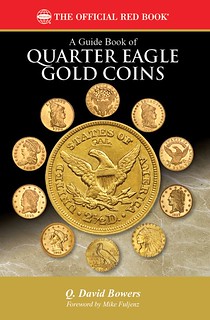 In the sixty-plus years Q. David Bowers has been studying the gold coins of the United States, he has examined countless related periodicals, read more than 5,000 numismatic catalogs, and consumed every available reference on the subject. Beyond this
In the sixty-plus years Q. David Bowers has been studying the gold coins of the United States, he has examined countless related periodicals, read more than 5,000 numismatic catalogs, and consumed every available reference on the subject. Beyond this book learning
he has personally studied hundreds of thousands of gold coins, and has cataloged many of the most famous coin collections ever sold.
Dave became a professional numismatist and coin dealer in the 1950s, when he was a young teenager. Back then gold coins weren't often seen in the hobby community. In his local coin club, even the older members rarely brought them in for show-and-tell, or to sell. Since the 1930s, Great Depression–era orders had legally restricted hoarding
of such precious-metal coins (although collectors could keep gold pieces of numismatic significance, and personal exemptions allowed any American to own a reasonable face-value amount). Those federal restrictions would abide until the early 1970s.
Starting with the Bicentennial gold-medal program, Congress and the Treasury Department would tinker with mass-market distribution of federal gold products, including the trial-and-error exploration embodied by the American Arts Gold Medallions and, finally, the debut of the nation's first widely successful gold-bullion program, the American Eagle coinage of 1986 to date. Today, Americans find it easier than ever to buy, sell, and trade gold coins. This includes numismatic offerings such as commemoratives, Proofs and Reverse Proofs, high-relief gold medals, and other collectibles.
Classic pre-1934 U.S. gold coins, too, are now easy to study and collect. Many factors contribute to this.
-
Since the late 1940s, the Guide Book of United States Coins (the popular
Red Book
) has given numismatics a strong boost, making the hobby accessible to more than just wealthy and leisured intellectuals; - starting in the 1950s, global economic conditions repatriated a flood of old U.S. gold coins, mainly from European bank holdings;
- in the 1980s, the development of modern professional third-party coin certification brought seemingly scientific stability to the art of grading, and gave birth to a robust sight-unseen market;
- since the 1990s, the communications boom and modern technology have made U.S. gold coins widely accessible for any collector with an Internet connection; and
- since the early 2000s, the modern renaissance of American numismatic book publishing has brought dozens of new books featuring U.S. gold coins into the hands of collectors and researchers.
A couple years ago I made an informal poll of 100 hobbyists. I found that roughly 10 percent identify themselves as very active
collectors of gold quarter eagles—e.g., constantly upgrading their sets, competing in registries, cherrypicking or collecting by die variety or die state, and/or holding membership in a dedicated group such as the Southern Gold Society. 20 percent were more casual, collecting quarter eagles (including in type sets) but not as their primary hobby niche. The remaining 70 percent were split evenly between those who own some of the coins but don't consider them a carefully assembled collection; and those who neither collect them nor own any.
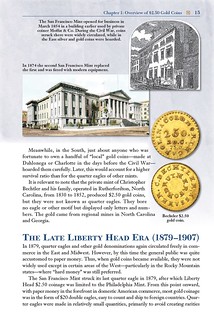 I found it interesting that two-thirds of these collectors owned quarter eagles and/or collected them either actively or casually. Comments included:
I found it interesting that two-thirds of these collectors owned quarter eagles and/or collected them either actively or casually. Comments included: I have about a dozen examples of genuine and counterfeits. Now I only collect the fake ones.
My main area of collecting; love them!
Yes, with a focus on Dahlonega issues. I am always on the hunt for the die and mintmark varieties of the 1839-D, 1841-D, 1843-D, and 1846-D/D.
No dirty old gold here! I collect the 1900–1907 Liberty Head quarter eagle short set in CAC-approved high grades (66/67). Love those little glowing gems!
I collect Indian Head quarter eagles—just a date set, though. The '11-D is out of my league.
I pretty much exclusively collect gold quarter eagles. My primary focus is a date run from 1796 to 1834, including Red Book varieties. Only 6 coins to go of the 24 needed. I've been at it for 10 years. I also collect ‘cool' Classic and Liberty Head quarter eagles.
I'm plugging away at a set, albeit very, very slowly. All are PCGS VG-8 or lower. Something special about gold lowballs.
Love them: By decade, by type, by mint.
Have a complete set of Indian quarter eagles—minus, surprise, surprise, the 1911-D.
In the 1950s this level of interest and excitement over gold quarter eagles was nowhere to be seen. It was decades in the future.
When Dave Bowers started in the hobby in the 1950s, books about gold coins were even rarer than the coins themselves. Researcher Walter Breen wrote a 24-page monograph on gold dollars in 1964. In 1975 numismatist David W. Akers, after spending more than 20 years researching gold coins (dollars in particular), published United States Gold Coins: An Analysis of Auction Records, Gold Dollars. Over the next seven years Akers compiled volumes covering every U.S. gold coin series. In the meantime Breen, too, continued to write monographs on other gold coins (up to the $10 denomination, published in 1967), and included gold coins in his two encyclopedias published in 1977 and 1988.
Other writers over time added to the hobby community's knowledge of U.S. gold coins. Researchers published their work in Numismatic Scrapbook Magazine, Numismatic News, Coin World, The Numismatist, Coins Magazine, and other periodicals. Historian Cornelius Vermeule explored the aesthetics of U.S. coinage, including gold, in Numismatic Art in America (1971). Coin World published its Almanac in several editions starting in 1975, providing much technical information and data. Kenneth Bressett and others codified the grading of U.S. coins, including gold, in the Official American Numismatic Association Grading Standards for United States Coins (first edition, 1978). Later, Richard Doty, curator of the Smithsonian Institution's National Numismatic Collection, wrote his broad-ranging America's Money, America's Story, and Roger W. Burdette crafted his award-winning Renaissance of American Coinage books from deep study of the National Archives, Treasury records, and other primary sources. The gold coins of individual mints were covered by specialists including Rusty Goe (Carson City) and Douglas Winter (Carson City, Charlotte, Dahlonega, and New Orleans). Mike Fuljenz helped popularize U.S. gold coins with his award-winning books on various series.
In the midst of this activity, Q. David Bowers emerged as the preeminent author on U.S. gold coinage—a position he holds to this day.
Bowers's History of United States Coinage, As Illustrated by the Garrett Collection, published in 1979, included his analysis of the nation's gold coins. In 1982 he published United States Gold Coins: An Illustrated History. His numismatic history of collecting U.S. gold coins was released as part of the proceedings of the 1989 Coinage of the Americas Conference. In various other books of the 1990s and early 2000s, plus hundreds of articles and columns before and since, he's shared stories and insight on U.S. gold coins.
In 2003 Bowers joined forces with Whitman Publishing, longtime publisher of the Red Book and other hobby books, signing on as the company's numismatic director. This collaboration has led to a boom in American book-publishing in the field of numismatics. Whitman publishes an average of one new book either entirely or substantially about gold coins every year, ranging from popular single-denomination guidebooks to (also popular) 650-page encyclopedias. The first came out in 2004: Bowers's Guide Book of Double Eagle Gold Coins was the first book to cover the entire spectrum of the $20 denomination since David Akers's 1982 volume on the subject. Among the more recent are Gold: Everything You Need to Know to Buy and Sell Today (by Bowers and Jeff Garrett, first published in 2010); Lost and Found Coin Hoards and Treasures: Illustrated Stories of the Greatest American Troves and Their Discoveries (Bowers, first edition 2015); and my own American Gold and Silver: U.S. Mint Collector and Investor Coins and Medals, Bicentennial to Date, published in 2016.
As Whitman's numismatic director, Dave Bowers has advised on all of these books, while keeping up his own prodigious and constant research and writing.
David W. Akers, who in the 1970s and 1980s broke new ground publishing his numismatic research, has said, If one had a library consisting only of books and auction catalogs that Dave Bowers has written, the field of U.S. numismatics would be quite thoroughly and satisfactorily covered. Such a claim could not be made about any other person, past or present.
The Guide Book of Gold Quarter Eagle Coins—the 26th volume in the Bowers Series, and the 20th of those volumes written by Bowers himself—expands and confirms that distinction.
A Guide Book of Quarter Eagle Gold Coins, first edition.
By Q. David Bowers; foreword by Mike Fuljenz.
ISBN 0794847331. Softcover, 6 x 9 inches, 448 pages, full color.
Retail $29.95 U.S.
https://whitman.com/a-guide-book-of-quarter-eagle-gold-coins/
And of course, don't forget Daryl Haynor's 2020 book, United States Classic Gold Coins of 1834-1839. -Editor
To read the earlier E-Sylum articles, see:
NEW BOOK: U.S. CLASSIC GOLD COINS OF 1834-1839
(https://www.coinbooks.org/v23/esylum_v23n12a02.html)
BOOK REVIEW: U.S. CLASSIC GOLD COINS OF 1834-1839
(https://www.coinbooks.org/v23/esylum_v23n28a04.html)
NEW BOOK: GUIDE BOOK OF QUARTER EAGLE GOLD
(https://www.coinbooks.org/v25/esylum_v25n04a03.html)
NEW BOOK: GREENBACKS AND GREYBACKS
News & Notes from the Society of Paper Money Collectors (Volume VII, Number 33, February 1, 2022) alerted me to a new book (actually, a PhD dissertation) titled Greenbacks and Greybacks: Iconographic Depictions of Union and Confederate Nationalism on Civil War-Era Currency. It's by Christian Martin Lengyel at the Kent State University Department of History. Here's the Introduction; the complete dissertation is available free online. -Editor
 The Civil War is certainly not a subject that has escaped the attention of scholars. In fact,
C. Vann Woodward's conclusion from over three decades ago still holds true:
The Civil War is certainly not a subject that has escaped the attention of scholars. In fact,
C. Vann Woodward's conclusion from over three decades ago still holds true: far more has been
written about these particular years than any others in American history.
But, as Woodward
goes on to mention, the more written, the more disclosed […] the more questions and
controversies
emerge to be coped with by latter-day historians.
Such is the case when it comes to nationalism and the differing stances of the Union and the Confederacy over what characterized proper mid-nineteenth century patriotism. Up to recently the literature on these issues remained remarkably scant. And while that trend has subsequently reversed itself, especially with regards to the Confederate States of America, there still has been surprisingly little attention paid to the northern theater as well as no in-depth side-by-side comparisons of the two fronts' nationalistic impulses. This dissertation intends to fill in those gaps.
Using the mediums of U.S. Greenbacks and C.S.A. Greybacks, this project highlights how Yankee and Rebel currency vignettes illustrated two disparate national ideologies. Namely that northern leaders continuously adopted agendas promoting the trustworthiness of the polity and the greatness of an integrated nation; whereas southern bureaucrats initially struggled with those concepts, only realizing their importance once public confidence in the Confederate States had eroded beyond repair. Therefore, at its most fundamental level, this manuscript argues that wartime monetary iconography developed in coordination with these differing viewpoints.
As a consequence, the North's early tableaus were far simpler and more consistent in their presentation than any of the South's Civil War issues; however, both sets of images evolved throughout the duration of the conflict, with the United States settling on a broader selection and the Confederacy adopting a stricter visual vocabulary. These changes, of course, also closely correlate to various economic and martial episodes that caused the U.S. and C.S.A. treasuries to significantly revise their financial policies as the need for a reliable currency system became more apparent. But although the explicit use of patriotic pictures – specifically of state-centered objects, individuals, and events – aided in those efforts, such displays did more than simply make paper dollars more palatable to the general public: they functioned as emissaries of the separate governments that released the notes themselves
To read the complete article, see:
Greenbacks and Greybacks: Iconographic Depictions of Union and Confederate Nationalism on Civil War-Era Currency
(https://etd.ohiolink.edu/apexprod/rws_olink/r/1501/10?clear=10&p10_accession_num=kent163762562877458)
NEW BOOK: BLOCKLAND
Encyclopedia of Physical Bitcoins and Crypto-Currencies author Elias Ahonen has published a new book about cryptocurrency. Another article in this issue notes that he is also serving as an authenticator of physical bitcoins. -Editor
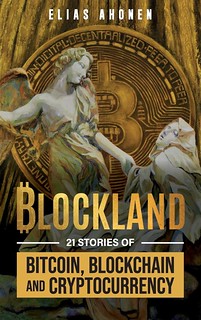 Elias Ahonen was described as
Elias Ahonen was described as one of the first Bitcoin historians
by Bitcoin.com for his 2016 Encyclopedia of Physical Bitcoins and Crypto-Currencies. Though he started professional life as an IT analyst and North Korea geopolitical researcher, he found himself in a whimsical seven-year career as an international blockchain consultant and dealer of million-dollar Bitcoin art, the story of which Cointelegraph labelled as perhaps cryptocurrency's first rock'n'roll biography
. His gonzo-style memoir serves as an intimate backdrop to the bigger story.
As an industry insider and a social scientist by training, Elias Ahonen gives an even and unbiased view of the space in a manner that is both easily accessible and utterly charming. There is no papering-over of the darker elements of cryptocurrency.
- The crypto-anarchist philosophical origins of Bitcoin
- Intertwined stories of 50 digital currencies
- Tales from the cryptocurrency mining industry
- How the Dark Web drug dealers gave Bitcoin its wings
- Billion-dollar heists of digital money
- The tribal and religious nature of the splintered crypto-culture
- Bitcoin's civil wars and Ethereum's ideological crisis
- Account of the making and aftermath of the 2018 ICO bubble
- Analysis of the global governmental reception of Blockchain
- How Non-Fungible Tokens (NFTs), Decentralized Applications (dApps), Decentralized Autonomous Organizations (DAOs), and Decentralized Finance (DeFi) present a new wave of disruption
- And much more!
For more information, or to order, see:
https://www.cryptonumist.com/
Blockland: 21 Stories of Bitcoin, Blockchain, and Cryptocurrency
(https://www.amazon.com/Blockland-Stories-Bitcoin-Blockchain-Cryptocurrency/dp/0995089965/ref=sr_1_1)
LINCOLN AND GARFIELD MEDAL CORRESPONDENCE
The latest addition to the Newman Numismatic Portal is a group of correspondence related to U.S. Mint medals of Lincoln and Garfield. Project Coordinator Len Augsburger provided the following report. -Editor
Lincoln and Garfield Medal Correspondence
The assassination of President James Garfield in 1881 quickly resulted in a medallic tribute from the U.S. Mint, featuring the busts of both Abraham Lincoln and Garfield. Medals were produced in gold and silver in both large (Julian PR-40, 25mm) and small (Julian PR-41, 19mm) format. Recently transcribed by Newman Portal are several pieces of U.S. Mint correspondence from the period, related to these medals. Julian notes these pieces were often used as charms, and indeed, the market today assigns strong premiums to pieces in the upper Proof range.
Images: Lincoln-Garfield medal, Julian PR-41, NGC PR64 Cameo, from Heritage Auctions 8/2014, lot 5055, realized $3,965.63.
Link to U.S. Mint Lincoln-Garfield medal correspondence:
https://archive.org/details/newmannumismatic?query=garfield+medal&sin=TXT&sort=-publicdate
VIDEOS: NNP ACQUISITIONS AND HOWARD GIBBS
These are selections from the David Lisot Video Library that feature news and personalities from the world of coin collecting. David has been attending coin conventions since 1972 and began videotaping in 1985. The Newman Numismatic Portal now lists all David's videos on their website at:
https://nnp.wustl.edu/library/multimediadetail/522852
Here's one on my talk at last fall's PAN show. -Editor
David writes:
"These lectures were videotaped at the Pennsylvania Association of Numismatics October 2021 Convention. PAN is a great show and is growing to be a major stop on the numismatic trail of national conventions. The bourse is dealer friendly and the educational lectures are excellent for collectors. E-Sylum editor, Wayne Homren, delivered a talk on Howard Gibbs, the "Indiana Jones" of primitive money collectors as well as an update on developments with the Newman Numismatic Portal."
- Newman Numismatic Portal Acquires Coin World and Numismatic News. VIDEO: 6:05.
- Wayne Homren, Editor, E-Sylum, David Lisot, Video Producer, October 29,2021.
- Two of the oldest numismatic print newspapers have been acquired by the world's largest website devoted to numismatic research.
To watch the Newman Portal segment, see:
CoinTelevision: Newman Numismatic Portal Acquires Coin World and Numismatic News
(https://youtu.be/NWYza66JWvk)
- Howard Gibbs: Prince of Primitive Money
- Wayne Homren, Editor, E-Sylum, David Lisot, Video Producer, October 29,2021.
- Learn the story of the man called the Indiana Jones of primitive money. Howard Gibbs went to great lengths to acquire examples of the different forms of money used all over the world. Learn about the forms of money that include golden fishhooks, money with a soul, wife buying money, Yap Stones, and more.
To watch the Howard Gibbs video:
CoinTelevision: Howard Gibbs: Prince of Primitive Money.
(https://youtu.be/DxRETtj5HU8)
COLLECTING NUMISMATIC BOOKS OF THE 1800S
Dennis Tucker of Whitman Publishing penned this Coin Update article on collecting the numismatic books of the 1800s. -Editor
As robust as the world of modern American numismatic publishing is, it's good to take a look backward from time to time.
Numismatists love to study and collect the hobby's foundational books, auction catalogs, and periodicals of the 19th century. There's an entire industry
(if that's the right word) devoted to buying, selling, and preserving these and similar objects of numismatic history.
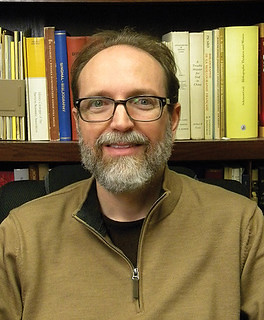 10 years ago, bibliophile David Fanning—since 2010 one-half of the rare-book firm of Kolbe & Fanning Numismatic Booksellers—wrote an engaging article for the March 2012 issue of The Numismatist (the journal of the American Numismatic Association).
10 years ago, bibliophile David Fanning—since 2010 one-half of the rare-book firm of Kolbe & Fanning Numismatic Booksellers—wrote an engaging article for the March 2012 issue of The Numismatist (the journal of the American Numismatic Association).
In Top 10 American Numismatic Books of the 19th Century,
Fanning says that Important works continue to inform and teach today's collectors.
He observes that in the 1850s, when the hobby of coin collecting was first beginning to flourish in America, there was only a small number of books on coins, medals, and paper money. Much of what was available was aimed more at merchants, economists, and government personnel,
he notes. This changed as the hobby continued to grow, and by the end of the 1800s the savvy collector could have built a sizable library.
Today, Fanning says, Even a casual collector on a modest budget can fill an entire bookshelf with useful numismatic literature in surprisingly little time.
His Numismatist article covers 10 publications of the 19th century that are considered numismatic classics today. Every collector who engages in conversations and explores the hobby to any depth will eventually hear these titles come up—books like Sylvester S. Crosby's The Early Coins of America (1875) and the Catalogue of John W. Haseltine's Type Table of U.S. Dollars, Half Dollars & Quarter Dollars (1881), and the periodical American Journal of Numismatics (started 1866) of the American Numismatic Society.
In a November 2015 interview with Coin World editor-at-large Steve Roach, Fanning opined on the future of numismatic literature collecting. I think future collectors will have a more sophisticated appreciation of the physical aspects of the book as artifact, and will continue to have a strong regard for the history of our hobby,
he said. As numismatists, we're all interested in history to one degree or another. Our customers tend more strongly to be historically minded, and I think this aspect will grow as the internet continues to grow as a repository for information.
To read David Fanning's thoughts on the Top 10 American Numismatic Books of the 19th Century,
visit the Kolbe & Fanning website.
To read the complete Dennis Tucker article, see:
Notes Published: Collecting the numismatic books of the 1800s
(http://news.coinupdate.com/notes-published-collecting-the-numismatic-books-of-the-1800s/)
To read the complete David Fanning article, see:
Top 10 American Numismatic Books of the 19th Century
(https://www.numislit.com/pdfs/Fanning_Feb2012Small.pdf)
MYSTERY ANSWER: ARE YOU A MAN OR A MOUSE?
Regarding the mystery "Rat Man Medal" Pete Smith asked about, Allen Berman writes:
"I have not done any research on this but I must say it does recall the famous saying, "Are you a man or a mouse?"
So perhaps the answer to "Is that a rat or a mouse?" is "mouse". Turns out to be a great guess. -Editor
Jeffry Johnson writes:
"It appears to be a variant of the Eddie Cantor Strike Me Pink Movie Advertising Token."
Jeffry passed along a link to this online listing. -Editor
1936 Eddie Cantor "Strike Me Pink" Movie Token Aluminum Diameter 27mm, Strike Me Pink is a 1936 American musical comedy film directed by Norman Taurog, starring Eddie Cantor and Ethel Merman, and produced by Samuel Goldwyn., this piece was part of the Lenard Babin collection of tokens, medals, militaria.
Jeffry also found an excellent reference on the site of the Queensland Numismatic Society. -Editor
In any ‘batch' of loose numismatic material you find the odd item. This item is a ‘spinner' or ‘decision maker' with a man on one side and a mouse on the other. As an advertising piece its aim is to be kept, used, and thus ‘advertise' the particular show.
The particular topic of this piece is an American actor Eddie Cantor in a movie called ‘Strike Me Pink'.
‘Strike Me Pink' was his last movie made for Samuel Goldwyn and was made in 1936. The story as outlined on www.imdb.com actually includes a coin as above. In the story Eddie has mail ordered a book titled Man or Mouse: What Are You?
accompanied with a record and a coin that has a man on one side and a mouse on the other. Eddie must continue to flip the coin until it comes up a man.
The ‘flipper' is in aluminium and was made by AMOR, which is the Sydney Company W.J. AMOR. It is likely that the token was made for the Australian/ New Zealand release of the movie as an advertising piece.
Thanks, everyone. Nice work! So it's a form of "flipper" token inspired by the 1936 movie. -Editor
Pete Smith adds:
"I agree with the concept that it is an "Are You a Man or a Mouse" flipper medal. I suspect that the version without lettering predates the movie advertising piece."
Interesting thought - that's quite plausible. One of these could have been the author's inspiration. But can we prove the pieces predated the book? Interesting tidbit: Author Clarence Budington Kelland wrote "Mr. Deeds Goes to Town" the same year. -Editor
Jeffry Johnson's links:
1936 Eddie Cantor Strike Me Pink Movie Advertising Token
(https://www.usacoinbook.com/item/1936-eddie-cantor-strike-me-pink-movie-advertising-token-533440/)
ARE YOU MAN OR MOUSE?
(http://qns.org.au/wordpress/information/articles-2/are-you-man-or-mouse/)
To read the earlier E-Sylum article, see:
NOTES FROM E-SYLUM READERS: JANUARY 30, 2022 : Query: Mystery Rat Man Medal
(https://www.coinbooks.org/v25/esylum_v25n05a12.html)
NOTES FROM E-SYLUM READERS: FEBRUARY 6, 2022
Thomas More's Utopia
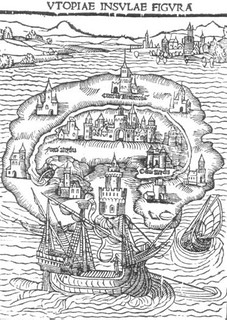 Jerise Fogel writes:
Jerise Fogel writes:
"I am looking for something (anything!) on Thomas More's Utopia and the choice he made in it to eschew silver and gold, trying somehow to get away from the idea of commerce and trade (but I guess particularly coinage). I'd love to read what anyone has to say about this!"
I found no references to the 1516 book in The E-Sylum archive, and only one on the Newman Portal: https://nnp.wustl.edu/library/book/529781?page=36 - and that's just a citation to a Yale University Press publication for an irrelevant mention.
Can anyone help? Sounds like an interesting topic. -Editor
For more information, see:
Utopia (book)
(https://en.wikipedia.org/wiki/Utopia_(book))
How High Exactly?
Ken Berger writes:
"Are you aware that in the article, "HIGH GRADE CONFEDERATE MONTGOMERY NOTE", you never listed the grade? I had to go to the original article to find out it was graded as a Choice Uncirculated 63."
I wasn't, but my response to Ken was, "Made you look! We rarely discuss grades or prices - there are plenty of other places to read that. Our readers and I don't need PMG to tell us it's a nice note - the image was enough." -Editor
To read the earlier E-Sylum article, see:
HIGH GRADE CONFEDERATE MONTGOMERY NOTE
(https://www.coinbooks.org/v25/esylum_v25n05a28.html)
Answer: Gadoury Chronograms Spotted
Last week I asked, "Who can spot the chronogram?" in the article about the March Gadoury sale of the Fernand David Collection. A chronogram is a hidden number, composed of letters that can represent a value in Roman numerals. Per Dick Johnson's Encyclopedia of Coin and Medal Terminology, a Chronogram is "Lettering which contains a date in Roman numerals that are in larger size for emphasis. The letters I, V, X, L, C, D and M are contained in words. The lettering, most often found in the legend, either spell out the date in these Roman numerals, or the numerals add up to the intended date. The date is most charming when it is in typical order of the date in proper number sequence."
Our winner is Andy Singer, the first (and only) reader to respond. In fact, Andy not only spotted the chronogram I had in mind, he spotted another one I'd missed. And for extra credit, he cyphered out the dates represented. Thanks, and congratulations! -Editor
"Lot 668 (Belgrade) has a chronogram for 1688. The next medal, lot 735 (Messina), also has a chronogram for 1718."
((No. 668 - Retaking of Belgrade from the Turks, 1688. Gold medal by Friedrich Kleinert. Rare medal of utmost historical importance. Extremely fine. Estimate: 20,000 euros.))
((No. 735 - Battle of Messina, 1718. Gold medal by G. W. Vestner. Very rare. Extremely fine. Estimate: 6,000 euros.))
To read the earlier E-Sylum articles, see:
VOCABULARY TERM: CHRONOGRAM
(https://www.coinbooks.org/v22/esylum_v22n08a17.html
THE WEDDING MEDAL CHRONOGRAM
(https://www.coinbooks.org/v22/esylum_v22n10a10.html)
GADOURY ANNOUNCES FERNAND DAVID SALE
(https://www.coinbooks.org/v25/esylum_v25n05a22.html)
JEFF BURKE'S NEW STANDING LIBERTY QUARTER
Jeff Burke submitted this article on his latest acquisition. Thanks! Nice coin. -Editor
Adding a Standing Liberty Quarter Type Coin to My Collection
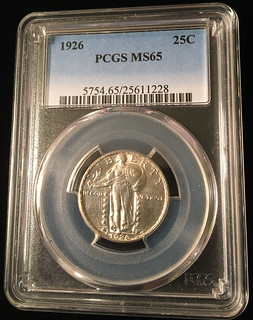 I remember the night that Tom Wood, president of our Lynchburg, Virginia Coin Club, was so
excited to show us his complete set of Standing Liberty quarters (SLQ) at one of our monthly
meetings! Tom's SLQ set took many years to complete and included a mint state 1916 specimen.
(For an intriguing story about 1916 SLQ patterns, see Steve Roach's
I remember the night that Tom Wood, president of our Lynchburg, Virginia Coin Club, was so
excited to show us his complete set of Standing Liberty quarters (SLQ) at one of our monthly
meetings! Tom's SLQ set took many years to complete and included a mint state 1916 specimen.
(For an intriguing story about 1916 SLQ patterns, see Steve Roach's Delicacies of Change: 20th
Century Patterns
in Coin World, November 2021, pp. 34-35).
Memories of that night and my own research about the SLQ series lead me to the treasure hunt of adding another piece to my small collection of high-grade, well-struck and inexpensive U.S. type coins in my favorite series: Indian Head cents, Lincoln cents, Buffalo nickels, Mercury dimes, Liberty Walking half dollars, Morgan dollars, Saint-Gaudens double eagles - and now Standing Liberty quarters.
Thomas G. Wood, Ph.D., was an important numismatic mentor to me during my membership in the Lynchburg Coin Club (LCC), from 2006 to 2012. Tom had had several articles about Standing Liberty quarters, Nickel Three-Cent pieces and Liberty Head nickels (his three specialties) published in The Numismatist in the 1970s. Tom taught me how to sharpen my skills as a grader and to be patient when hunting for that elusive coin.
Before starting the search for a SLQ for my own collection, I reread sections of Q. David Bowers' A Guide Book of Mercury Dimes, Standing Liberty Quarters and Liberty Walking Half Dollars, 2015, and J.H. Cline's Standing Liberty Quarters, 2007. In Cline's seminal work, my favorite sections were when the author reminisced about collecting and selling SLQs in the 1950s. I also read extensive information about Standing Liberty quarters on the Newman Numismatic Portal.
After considering the options within my price range, I opted to search for a 1917 Type I SLQ because it is by far the most well struck coin in the series. In Ron Pope's limited survey of 1917 Type I SLQ, 76% had full details. (Bowers, Guide Book, p. 163). My goal was to find a choice piece in MS 62 to 65, certified by NGC or PCGS. I studied dozens of specimens (full head and non-full head) on eBay and the Collectors Corner ranging in grades from Fair 2 to MS 67+. In the end, I was most captivated by a 1926 SLQ PCGS MS-65 white gem from Northeast Numismatics that I discovered on Collectors Corner. In Pope's survey on 1926 SLQ, only 1% had full details. (Bowers, Guide Book, p. 179). Although not in the full details category, the coin that captured my attention still stood out for its overall beauty and luster.
This stellar quarter arrived in the mail in late January. It looks even better in person than it did during my online examinations. My wife has declared it the most beautiful coin I've ever purchased!
Remember: Buy the book before the coin! -Editor
PHYSICAL BITCOIN AUTHENTICATORS
Back when we covered the recent sale of a 2012 physical bitcoin I asked, "What exactly is PCGS certifying here? The holder states that it is a 2012-dated "Casascius Bitcoin 1oz .999 Find Gold." It also lists a denomination of "1000 BTC". But how could they certify that the unopened private key is there, correct and recoverable? Was the returned slab accompanied by a lengthy legal disclaimer?"
Well, one physical bitcoin author and researcher (is there more than one?) has hung out his shingle as a Casascius coin authenticator. -Editor
 4K.com, the world's first marketplace for physically-backed non-fungible tokens (NFTs), just sold a rare unpeeled 1 BTC Casascius coin at 3.5x the face value and added Elias Ahonen as a Casascius coin authenticator.
4K.com, the world's first marketplace for physically-backed non-fungible tokens (NFTs), just sold a rare unpeeled 1 BTC Casascius coin at 3.5x the face value and added Elias Ahonen as a Casascius coin authenticator.
With only 19,752 unredeemed Casascius coins left, markets for these coins are experiencing high premiums. Prior to 4K offering Casascius coins on their marketplace, prospective buyers would have to search various forums for sellers, ask for references to ensure the seller is legitimate, and either trade in person or send funds ahead of time hoping that the seller will follow through with the trade and that the coin will be authentic. 4K streamlines this process by pre-authenticating each coin, which enables buyers and sellers to trade with confidence. With Elias onboard, 4K now has one of the world's foremost experts formally signing off on authenticity.
Elias is the author of the Encyclopedia of Physical Bitcoins and Crypto-Currencies and operates cryptonumist.com, which aims to spread knowledge about these coins. He has been recognized internationally in the media and elsewhere as a subject-matter expert. As Casascius coins become increasingly recognized as tangible relics of the blockchain revolution and the value of the enclosed BTC rises, authentication becomes all the more important,
says Elias.
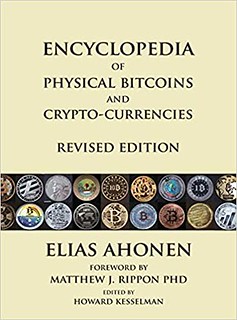 There is now a new ungraded Casascius coin listed on the 4K marketplace authenticated by Ahonen. Produced by Mike Caldwell between 2011 and 2013, these coins enable newcomers to the bitcoin community to physically hold bitcoin, which helps overcome mental blocks around the idea of an intangible internet money. Each coin is equipped with a unique private key that is hidden behind a tamper-evident hologram. When peeled, the hologram leaves residue that shows future coin holders that the $BTC has been unloaded. The rarest Casascius coins are gold and contain the private keys to 1000 BTC, making them the most valuable coins in the world valued well above 40 million dollars each.
There is now a new ungraded Casascius coin listed on the 4K marketplace authenticated by Ahonen. Produced by Mike Caldwell between 2011 and 2013, these coins enable newcomers to the bitcoin community to physically hold bitcoin, which helps overcome mental blocks around the idea of an intangible internet money. Each coin is equipped with a unique private key that is hidden behind a tamper-evident hologram. When peeled, the hologram leaves residue that shows future coin holders that the $BTC has been unloaded. The rarest Casascius coins are gold and contain the private keys to 1000 BTC, making them the most valuable coins in the world valued well above 40 million dollars each.
To read the complete article, see:
Rare 1 BTC Casascius Coin NFT Sells for 350% Above Peel Value On The 4K Marketplace
(https://www.businesswire.com/news/home/
20220120005947/en/)
To read the earlier E-Sylum articles, see:
2012 GOLD CASASCIUS 1000 BITCOIN GRADED
(https://www.coinbooks.org/v24/
esylum_v24n41a12.html)
NEW BOOK: ENCYCLOPEDIA OF PHYSICAL BITCOINS
(https://www.coinbooks.org/v24/
esylum_v24n45a05.html)
REDISCOVERING ELIASBERG'S CONTINENTAL DOLLAR
A new blog article by researcher Ron Guth of the Numismatic Detective Agency continues his Eliasberg Project with a look at the Eliasberg Continental Dollar. Here's an excerpt - see the complete article online. -Editor
In addition to his phenomenal collection of United States coins, Louis Eliasberg, Sr. built impressive collections of world gold, pattern coins, and U.S. colonial coins. For those of us who were around for the sales of his U.S. coins in 1982, 1996, and 1997, it's hard to believe that a quarter of a century has passed. During that time, his coins have either remained with the original buyers or they may have appeared and re-appeared on the market. In many of those reappearances, the Eliasberg provenance has simply gone missing, severing the ties to this important collection. Thus, the Eliasberg Project has become a personal challenge to identify Eliasberg coins and to re-establish the Eliasberg provenance chain where possible. A further goal of the Eliasberg Project is to present modern
grades (where known) to give the Eliasberg coins their proper ranking in the Numismatic Detective Agency (NDA) Condition Census.
Rediscovering an Eliasberg provenance is a real thrill, especially when it involves one of his more important coins. One such coin was his 1776 Continental Dollar
(I put quotes around the word Dollar because of the ongoing debate about the origins of the Continental coinage). Recently, I was able to restore the lost Eliasberg pedigree to a Continental Dollar
that appeared three times at auction with no mention of his prior ownership.
Eliasberg owned only a single Continental Dollar
, but it was a nice one. When his coin sold as Lot 50 in Bowers & Merena's May 1996 sale of the Eliasberg Collection, it was described as MS-63 or finer.
The cataloger (presumably Q. David Bowers) gave the coin a nearly full column, half page writeup. The coin was illustrated in black-and-white along with the lot description, and in color in the plates near the front of the catalog. No prior provenance was provided.
In April 2002, Eliasberg's Continental Dollar
reappeared in a Heritage auction as Lot 4002. By then, PCGS had assigned a grade of MS64 and the coin realized $43,700, nearly doubling in value in the intervening six years. No provenance was provided.
Ten years later, the coin reappeared in the August 2012 Heritage sale as a PCGS MS65, this time as part of the Liberty Collection, where the price soared to $246,750. No mention was made of the Eliasberg provenance.
Half a year later, the Eliasberg Continental Dollar
reappeared as Lot 1370 in a February 2013 Goldbergs sale, again as a PCGS MS65, but the price dropped to $212,750. The catalog description included the Liberty Collection provenance but no mention of the Eliasberg provenance.
I am unaware of any subsequent auction appearances of this coin.
Where is this coin today? See the full article for a description of the diagnostics. Clickbait headline: You could be rich! Do you have Eliasberg's dollar in your pocket change? -Editor
To read the complete article, see:
The Eliasberg Project: Rediscovering His Continental "Dollar"
(https://numismaticdetectives.com/blog/f/the-eliasberg-project-rediscovering-his-continental-dollar)
THE BOOK BAZARRE
VOCABULARY TERM: HIGHLIGHT, HIGHLIGHTING
Here's another entry from Dick Johnson's Encyclopedia of Coin and Medal Terminology. -Editor
Highlight, Highlighting. Creating a contrast of light and dark areas on a metal surface. Highlighting a medallic item puts dark coloring in crevices and some low areas of the relief, and, by burnishing or buffing, making the higher areas lighter in color. The relief stands out because of this two-toned effect, the contrast aids the human eye in perceiving the total view. Highlight is the result of oxidation (actually a sulphatization) and this relieving.
Most patina finishes will employ some form of highlighting and this is a major function of the finishing department. There is no highlighting in coin finish, as coins and tokens receive no finish after they are struck; for most medallic work, however, it is the next important step after the medals are fully struck, trimmed and edgemarked.
How medals are highlighted. Medallic items come to the finishing department in tote boxes, they are fully struck up and edgelettered – all the steps of the pressroom are complete including trimming and any edge treatment. The medal at this stage is called a raw medal. The first step is an abrasive blasting with very fine abrasive particles, as sand or glass beads; this gives the raw medal surface a "tooth" to accept further finishing treatment, particularly with fluids. Actually these microscopic pits are called cups to retain the liquid.
The abrasive is grossly removed, by shaking off all loose particles, the medals are then placed into wire baskets and doused into a darkening solution (as ammonium sulfate). Immersion time is critical, being removed quickly after the desired darkness has occurred, the medals are then thoroughly washed to stop the darkening action by immersion in still water or running water or both. This washing also removes any residual abrasive particles.
At this stage the medals are totally black or as dark as desired – one color. They are brought to a workbench where a wet wheel is located. A medal is covered with a pumice slurry and buffed on the wet wheel to remove the dark toning on the high points, on flat surfaces and all areas coming in contact with the buffing wheel. The dark color remains in the crevices and near some relief where it outlines and thusly emphasizes or highlights the relief. This forms the two-toned effect.
Afterwards the medals are washed of all pumice and dried; at this point they are even baked to remove all possible moisture, then lacquered. Some highlight action may continue under the lacquer; such residual toning can be observed in about six month's time and continues, possibly, for several years.
To read the complete entry on the Newman Numismatic Portal, see:
Highlight, Highlighting
(https://nnp.wustl.edu/library/dictionarydetail/516049)
THE RIM VERSUS EDGE OF A COIN
While we're on the topic of numismatic terms, this January 31, 2022 article by Joshua McMorrow-Hernandez on the PCGS website provides a nice definition of the rim and edge of a coin. -Editor
Rim, edge… Aren't these just different words for the same part of a coin? No, not at all… The rim and edge are as different from each other as the obverse (or head's side
) and reverse (often called the tail's side
). When it comes to coins, many people may confuse the rim and edge because these terms often have similar definitions when used in other contexts. For example, you might say you're going to fill the cup to its rim,
which means the edge of the cup.
But rims versus edges on coins? Well, in numismatics, the rim and edge simply aren't one and the same…
Rim
The rim of a coin refers to the raised ridge encircling the circumference of the obverse and reverse of a coin. The rim is fully visible when looking squarely at the coin's obverse and reverse. On most modern coins, the rim is unadorned, taking on the appearance of a thick, solid border or frame around the obverse or reverse. On many classic coins, the rim may be ornamented with denticles or other aesthetic frills.
Edge
A coin's edge is also known as the third side of a coin, and it's often one of the least photographed or illustrated portions of any coin. The edge may be plain (flat), reeded (has lines or grooves), include edge lettering, or boast other features to bolster the coin's security or offer other visual or technical benefits. The edge is every bit as important to study as the rest of a coin and can even be used to determine whether a coin is authentic, i.e. – many cast counterfeits exhibit a telltale seam around the edge.
To read the complete article, see:
The Rim Versus Edge of a Coin
(https://www.pcgs.com/news/rim-versus-edge-of-a-coin)
LORIN GILBERT PARMELEE (1827-1905)
American Numismatic Biographies author Pete Smith submitted this article on Boston collector Lorin Parmelee. Thanks! -Editor
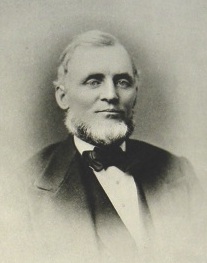 In the nineteenth century, the coin collection of Lorin Parmelee has been called the
In the nineteenth century, the coin collection of Lorin Parmelee has been called the greatest coin collection ever
sold at auction.
In truth, much of the collection did not sell at that auction. Various sales of duplicates were offered
before the primary sale in 1890.
It is hard to find two records that agree on the facts of his life. His first name is variously spelled Lorin or Loring. His last name was Parmelee or Parmalee. Various names are given for his mother and his wife.
In 1890, New York Stamp & Coin conducted the major auction of his collection. It listed his name as Lorin G. Parmelee and included a picture with his signature as Lorin Parmelee. In that same year the Boston City Directory listed his name as Loring G. Parmelee. Rather than attempting to prove one name is right, it is better to recognize that both names were used.
Attinelli (Numisgraphics) states, Mr. Loring G. Parmelee was born in the town of Wilmington, Vt., May 7th,
1827.
Massachusetts records indicate that Lorin G. Parmelee was born in Chelsea, Massachusetts, on May 8, 1827.
The 1830 and 1840 U. S. Census did not list the names of children in households. No listing was found for 1850. In the 1860 Census, he was listed as Loring G. Parmalee, married to Addie and born in Vermont. The 1865 Massachusetts Census gives his last name as Parmales and age as 40, married to Adda. In 1870 he was listed as Loring G. Parmalee, married to Addie and born in Vermont. In 1900 he was again listed as Loring G. Parmelee.
Parmelee was the son of Jeremiah Parmelee (1799-1868) and Lydia Corinthe Parmelee (1803-1830), also known as Corintha Lydia Ray. Their Findagrave listing does not mention Lorin as a son.
On May 19, 1856, Loring Parmelee married Adeline Sargent (1829-1909). Their children were George L. Parmelee (1857-1920) and Emily Corinthia Parmelee Howarth (1858- ).
Parmelee moved to Illinois at age 21 but soon returned east to Boston. He was in the alliterative business of baking beans and brown bread. He delivered beans in black iron pots to hotels and restaurants around the area. He looked for coins in his daily receipts and sold of collectible duplicates.
He expanded his collection by buying up the Seavey collection for $15,000 in 1873, the Brevoort collection in 1876, the Bushnell collection in 1882 and parts of the Crosby collection. He consigned duplicates from Seavey through a Leavitt sale on June 18, 1873 and from Bushnell through the Chapman brothers for June 20-24, 1882. He was not satisfied with prices and bought back many of the Bushnell coins.
The primary Parmelee collection was sold by Harlan Smith and New York Coin and Stamp on June 25-27, 1890. Prices from the sale were depressed with many items in the sale bringing less than at the previous 1882 Bushnell sale. Some lots remained unsold. The sale is remembered for the quality of the selections and for an incident that occurred at the sale.
Dealers Ed Frossard and Lyman Low got into a dispute over the clover leaf cent, tussled, and rolled on the floor trying to kick each other. Auctioneer Smith stepped in to break up the fight and lost a diamond stickpin for his efforts. The coin was sold to dealer Charles Steigerwalt for $79.
Parmelee died on July 22, 1905 at Danvers Insane Hospital. The death certificate gives his name as Loring G. Parmelee. The cause of death was broncho pneumonia with senile dementia as a contributing factor.
Thanks! $15,000 in 1873 was an astounding sum for a coin collection. What a numismatic appetite Parmelee had! -Editor
To an earlier E-Sylum article, see:
1792 WASHINGTON PRESIDENT GOLD EAGLE PROVENANCE
(https://www.coinbooks.org/v21/esylum_v21n31a28.html)
HARVEY STACK'S NUMISMATIC FAMILY, PART 114
As noted last week, Stack's Bowers has a backlog of Harvey Stack's numismatic memoir articles and will continue publishing them. In this one he discusses auction sales of 1993. -Editor
Harvey Stack loved to tell stories and his favorites were those about his family and the history of Stack's. While he passed away on January 3 of this year, he had already penned his remembrances through 1999. We believe Harvey would want these articles to be read and enjoyed and so we are pleased to continue the story of his life in numismatics.
1993 presented a wealth of numismatic material for Stack's to offer at public auction, 10 catalogs in total. It was a year when we were pleased to produce outstanding catalogs and sell important collections. We started the year in January with some additional high quality coins from the Floyd T. Starr estate -- gold, silver and copper items that had not been included in the earlier sales. Some were duplicates, but even these included rare dates and mintmarks in extremely choice grades.
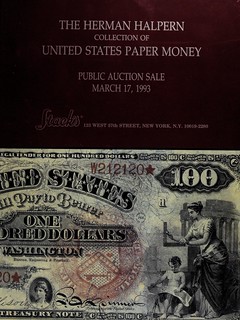 Featured in our March 1993 was the Herman Halpern Collection of United States Paper Currency, built by a collector that Stack's had had the privilege to serve for nearly four decades. Herman had started collecting after he left the Navy in 1955 and opened a number of saloons around midtown Manhattan. He had the afternoons free so he was a frequent visitor to Stack's "clubhouse," where he met quite a few dedicated collectors and expanded his knowledge with what he learned from them and the Stack family.
Featured in our March 1993 was the Herman Halpern Collection of United States Paper Currency, built by a collector that Stack's had had the privilege to serve for nearly four decades. Herman had started collecting after he left the Navy in 1955 and opened a number of saloons around midtown Manhattan. He had the afternoons free so he was a frequent visitor to Stack's "clubhouse," where he met quite a few dedicated collectors and expanded his knowledge with what he learned from them and the Stack family.
He became enthralled with U.S. paper money and built a major collection that included colonials, Demand Notes, Legal Tender Notes and Silver Certificates, Gold notes, Fractional Currency, Nationals and Federal Reserve notes. He also had a splendid collection of Confederate currency. He was attracted to the wide variety of paper money that circulated in the United States. He tried to find the best condition available and so many of his notes were full Mint State. The sale included 922 lots and was one of the largest and most popular offerings of paper money that Stack's ever presented at auction.
In that same month Stack's also offered a comprehensive assortment of United States gold, silver and copper coins that ranged from early type coins through later issues, including some scarce and rare dates, as well as Mint State and Brilliant Proof examples. It was another nice "something for everyone" Stack's auction.
May once again brought our special sale in conjunction with the Greater New York Numismatic Convention, sponsored by nine numismatic clubs from New York, Brooklyn, Long Island, the Bronx, Westchester, Connecticut and New Jersey. This catalog of 1,500 lots was a broad offering of United States gold, silver, and copper as well as colonial issues. As always, we tailored our sale to appeal to the wide variety of people who attended the convention, so they were able to add to their collections while at the show. It was a highlight of the numismatic year for those who were able to attend.
Our first June catalog, dated June 14, 1993, contained over 1,500 lots of ancient coins and foreign gold , silver and copper, featuring superb collections of gold coins from Mexico and a specialized collection of gold and silver coins from Peru. This important offering brought in collectors from Central and South America seeking hard to locate coins from early Spanish Colonial days to the 20th century. It was a rare chance to add to specialized collections of Mexico and Peru.
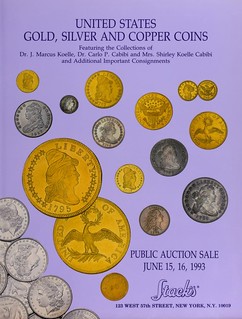 On June 15 and 16 we offered several consignments of United States gold, silver and copper coins featured in a separate catalog. This auction included the collections of Dr. J. Marcus Koelle, Dr. Carlo P. Cabibi and Mrs. Cabibi, and the catalog was carefully blended to complement each collection. Together the consignments offered more than 2,500 lots and presented coins for average collectors as well as rarities for specialists. It also contained quantity lots of gold coins for investors and dealers - lots of five to 20 coins of the same date and mint, all in Mint State that had been saved from the melting pot years ago. In addition, there was a great selection of U.S. half eagles starting in 1795, the exceedingly rare $5 and $10 struck by Templeton Reid and, at the end of the sale, a large group of Mint State Morgan dollars presented in bulk lots and rolls. This large sale consisted of both day and night sessions, and it attracted so many bidders in person, by bid sheet and over the phone that each evening session took until after midnight to complete.
On June 15 and 16 we offered several consignments of United States gold, silver and copper coins featured in a separate catalog. This auction included the collections of Dr. J. Marcus Koelle, Dr. Carlo P. Cabibi and Mrs. Cabibi, and the catalog was carefully blended to complement each collection. Together the consignments offered more than 2,500 lots and presented coins for average collectors as well as rarities for specialists. It also contained quantity lots of gold coins for investors and dealers - lots of five to 20 coins of the same date and mint, all in Mint State that had been saved from the melting pot years ago. In addition, there was a great selection of U.S. half eagles starting in 1795, the exceedingly rare $5 and $10 struck by Templeton Reid and, at the end of the sale, a large group of Mint State Morgan dollars presented in bulk lots and rolls. This large sale consisted of both day and night sessions, and it attracted so many bidders in person, by bid sheet and over the phone that each evening session took until after midnight to complete.
To read the complete article, see:
Growing up in a Numismatic Family: Part 114
(https://www.stacksbowers.com/News/Pages/Blogs.aspx?ArticleID=growing-up-in-a-numismatic-family-part-114)
To read the earlier E-Sylum article, see:
HARVEY STACK'S NUMISMATIC FAMILY, PART 113
(https://www.coinbooks.org/v25/esylum_v25n04a20.html)
DON EVERHART'S CAREER IN COINS, PART 2
With permission, we're republishing excerpts of former U.S. Mint Sculptor-Engraver Don Everhart series published by CoinWeek beginning in April 2018. -Editor
In addition to coins and medals I sculpted toys, giftware, figurines, plates, life-size figurative monuments, Disney figures, flatware for Tiffany's and many more different projects.
In 1982 I designed and sculpted Dance of the Dolphins
for the Society of Medallists. This was a medal program where two medals a year were given to subscribers. I've always had a deep interest in the ocean and the animals that inhabit it. I executed my design, and a few months later entered it in a reliefs and medals show in New York City held by the National Sculpture Society. Much to my surprise it won first prize and gave me a lot of confidence in my design and sculpture abilities.
In 1993 I sculpted Tyrannosaurus Rex
, again for the Society of Medallists. This medal was so popular that I was commissioned to sculpt five more dinosaur medals to create a set. Each medal showed the living dinosaur in its natural habitat with contemporary wildlife on the obverse. The reverse contained the fossil remains of the animal in the process of being freed from stone by the hand of a paleontologist.
Unfortunately, this unique series was discontinued in 1995. But I feel very honored to be in the company of the other sculptors that contributed to it.
In or about 1991 I was delivering a sculpt to the Franklin Mint and was chatting with Charles Vickers, who was still on staff at the time (I later worked with Charles at the United States Mint. In fact, we were both hired on the same day!). He told me about another medal series that was of great interest to me. It was a medal series by Brookgreen Gardens in South Carolina. Brookgreen Gardens is a classical sculpture garden and wildlife preserve near Murrells Inlet. One medal a year is given to members of the gardens. The theme had to be either the flora and fauna of South Carolina or the history of the state.
I have always been fascinated by dinosaurs, reptiles and all things creepy crawly, and decided that I'd design a die-cut medal of a hermit crab that lives near the beach at the gardens. It was a freestanding medal that was both cast and struck according to the Medallic Art Company, which produced it. I actually sculpted it in two separate halves that would line up and orient to each other when put together. It was the first freestanding medal in the Brookgreen series and had a very whimsical quality to it. The obverse shows the animal from the front, inhabiting its shell, with claws emerging from the bottom left and right; the reverse shows the swirl design of the shell with the lettering, Brookgreen Gardens, South Carolina
. In this instance I was inspired by the psychedelic lettering on concert posters from the 1960s. After all, I am a child of the '60s.
In 1996 I was contacted by Bob Hoff, the owner of Medallic Art Company–which, at the time, was the premier mint in the production of medals in the country. I had done a lot of calendar medals for Bob, an assignment I enjoyed because medals offer more freedom in design than coins. Medals have higher relief to work with and one doesn't have to design with proof coin parameters design in mind.
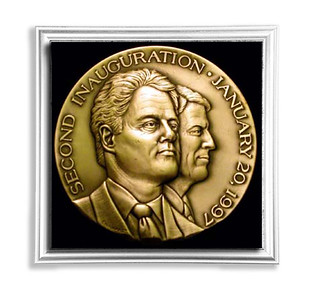 He asked me to design an inaugural medal for the second Clinton Administration. I was very hesitant at first. I told him that the project was a lot of work to be done on speculation. The artist would only get paid if the design was chosen by the president or the Inaugural Committee. I would have to design an obverse with both Bill Clinton and Al Gore, and pair it with a fitting presidential reverse. I fought Bob for a while, not wanting to invest the time and effort.
He asked me to design an inaugural medal for the second Clinton Administration. I was very hesitant at first. I told him that the project was a lot of work to be done on speculation. The artist would only get paid if the design was chosen by the president or the Inaugural Committee. I would have to design an obverse with both Bill Clinton and Al Gore, and pair it with a fitting presidential reverse. I fought Bob for a while, not wanting to invest the time and effort.
But he got me with this: I think you can win it.
To read the complete original article, see:
Don Everhart: My Career in Coins, Part 1 – The Franklin Mint
(https://coinweek.com/modern-coins/don-everhart-my-career-in-coins-part-1-the-franklin-mint/)
You can see more of Don's sculpture and design work on his website:
http://doneverhartsculpture.com/?utm_source=coinweek
To read the earlier E-Sylum article, see:
Don Everhart's Career in Coins, Part 1
(https://www.coinbooks.org/v25/esylum_v25n05a17.html)
'UNSEARCHED VAULT BAGS' AD REVIEW
Missouri Numismatic Society President Chris Sutter saw last week's item about the 'Unsearched Vault Bags' Consumer Warning, and kindly passed along a related article he wrote last July for the MNS's annual publication, the Missouri Journal of Numismatics. With permission, we're republishing the article here. Thanks! -Editor
by C. Joseph Sutter
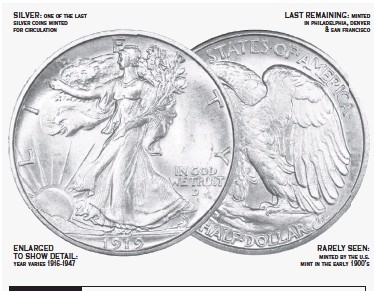 In the St. Louis Post Dispatch, the exclusive St. Louis newspaper, advertisements have
been appearing over the past year offering coin investments. As a coin collector these
ads seem to offer numismatic investments to the uninformed. They offer fantastic
In the St. Louis Post Dispatch, the exclusive St. Louis newspaper, advertisements have
been appearing over the past year offering coin investments. As a coin collector these
ads seem to offer numismatic investments to the uninformed. They offer fantastic
deals
and claim that collectors and dealers will be attempting to purchase all the item
quantities before the general public has a chance.
So what is the story behind these ads?
For this article, five ads covering five different items were reviewed. These ads appeared
in the St. Louis Post Dispatch on December 15, 2020, January 20, 2021, January 26,
2021, April 08, 2021 and June 7, 2021.
The ads were all headlined by ADVERTISMENT
followed by, except for the last ad,
SPECIAL ADVERTISMENT FEATURE. They offered, respectfully:
- Bags of over 100 U.S. Gov't issued coins dating back to the 1800's, limit twenty
- First Bank of the United States Jumbo Gold bars with the destination state stamped on it, no limit
- Rolls of ten Morgan Silver Dollars labelled with State of Missouri RESTRICTED on the wrapper, limit four
- Rolls of ten Missouri one ounce silver ingots, limit four
- Bags of three pound (over 100) U.S. Gov't issued coins dating back to the 1800's, no limit.
Where are these ads from? Canton, Ohio. To be more precise: The Lincoln Treasury, Inc (ad 1) and the National Mint and Treasury (ads 3,4) are in Canton while the Federated Mint, LLC (ads 2,5) is in Massillon which is 8 miles from Canton.
Other interesting observations:
- The bags in ads 1 and 5 look identical. Both ads state that after the bags were filled, my emphasis, the dates were never searched and the bags were sealed
-
The gold bars not only have Property of the First Bank of the United States
stamped on them they also say
EST. 1791
making you think the bars were created back then. They are also stampedMissouri
which conflicts with the 1791 date since Missouri did not exist until 1821 -
The bars are stamped
.999 Gold
and statea full 20 ounces of 24 Karat Gold and valuable bullion copper
. Since another part of the ad tells you these are mainly copper the offering firm would tell you that the ad is not misleading you into thinking more gold is present then actually is. I believe it is misleading. - All the offers are restricted to local residents: Missouri residents (ads 2,3,4) or selected zip codes (ads 1,5)
- All the offers are time conditioned: two days or 48 hours. Note: since these are the same time frame the advertisers are probably seeing which of the references yields the best results
- All offers have penalties if the deadline is missed: offer extended to beyond stated group and/or increased price.
- None of the offers provide grades of the coins.
-
Browsing the offering firms websites:
- National Mint and Treasury – website just has text from ad 3
- the Federated Mint, LLC – due to coronavirus concerns their phone lines are closed. They are trying to ship previously received orders. It says this in June 2021 even though most businesses have moved on from this limitation.
- The Lincoln Treasury, Inc – they do have an active website which features items similar to those offered in the ads.
So what about the price, is it a good one?
- $49 per bag. The ad shows a 1908-S Indian Cent (value estimated in the ad at $90.00), a 1914-D Lincoln Cent (value estimated at $215.00) and a 1943-S Steel Lincoln Cent (value estimated at $6.00) but does not indicate the grade of these coins nor promise that one of these will be in the bag.
- $49 per ounce or $980 for a brick, the basic sales unit. A Brick is four bars, each bar is five ounces. Each bar is five ounces of high demand bullion copper layered in 24 karat gold. With copper at $4.27 / ounce that's $85.40 for the twenty ounce Brick. Depending on the amount of gold in the layer, $980 seem high.
- $59 per coin $590 per roll. Since each Morgan dollar contains .77344 ounces of silver and silver is under $30 per ounce and condition is not specified, $59 seems high.
- $79 per coin $790 per roll. Similar to Morgan Dollar. While these coins are one ounce of .999 silver $79 seems high.
- $980 per bag. In one part of the ad these coins are: silver, scarce collectible and non-circulating U.S. coins. When describing the coins they include bicentennial quarters, wheat cents and Buffalo nickels. The descriptions conflict. Seems high.
The words in the ads were chosen to instill confidence in the buyer if they are not read carefully and analyzed to determine their meaning. For example: stating that the coins in ads 1 and 5 were not searched after sealing them in the bags implies un-searched coins. A careful reading discovers that the coins could have been selected before placing them in the bag.
The ads also contain quotes from famous or at least famous sounding people to justify the value of the items. Ads 2 and 5 use Mary Ellen Withrow as a source. Who is Mary Ellen Withrow? She was the 40th Treasurer of the United States. Appointed by Bill Clinton she served from 1994 – 2001. She is ninety years old. The ads call her emeritus Treasurer which is a fancy way of saying she was formerly in the job. She is not quoted as to the value of the items, only about how they are offered. If you think she is recommending the purchase, she is not. She is telling you that a limited window of ordering exists.
Ad 3, for the Morgan Silver Dollars is representative of the potentially misleading word
choices. The ad does not refer to Mary Ellen Withrow by name, instead she is retired
Treasurer of the United States of America
. She is quoted as saying In all my years as
Treasurer I've only ever seen a handful of these rare Morgan Silver Dollars issued by the
Gov't back in the 1880's. Since Morgan Dollars are easily available and can be found at
numerous coin shows or retail locations by numerous dealers, her statement lacks
credibility. The ad mentions the possibility of finding a 1892-S worth thousands of
dollars in the unsearched rolls. It does state that there are never any guarantees
. I agree
with the ad on this point.
The ad refers to the rolls as Restricted
because the coins are placed in a paper wrapper
with the words RESTRICTED / FOR MISSOURI STATE RESIDENTS ONLY
printed
on them. I am not sure how restricted this really is. In fact any roll not purchased within
the time window maybe be purchased by non-Missouri residents, for an increased amount
of $136 / coin or $1,360 a roll.
While no grade for the Morgan Dollars is provided, ad 3 does mention the Official Red Book, A Guide Book of United States Coins and illustrates four specific coins: 1886-S, 1888-S, 1896-S and 1899-P. Looking at the 2021 addition of the book the values stated in the ad match the values for grades vf-20 through ms-60. The ad also states that all Morgan's are worth a minimum of $125. Of course they did not offer the 1881-S or 1882-S as examples.
The offering firm's websites do not inspire much confidence since one is basically shut down, another only has the one ad in it and the third offers a few similar type items. None of the websites provide information about the company or other pertinent information.
Are these good deals? I admit that I entered this research with a closed mind. I thought
the ads were intending to sell overpriced numismatic items to unknowledgeable people.
Since ad 3 say the rolls make amazing gifts for … children, parents, grandparents,
friends or loved ones
, it does not appear that the target market is collectors. No collector
would think this is money well spent. Nothing in my research changed my mind. I
believe the items are vastly over-priced and should be avoided.
Chris couldn't provide images of the specific ads reviewed, but he was able to send the above image from a February 4, 2022 Post-Dispatch ad featuring Walking Liberty Half Dollars. Thanks. -Editor
To read the complete journal issue on the Newman Numismatic Portal, see:
Missouri Journal of Numismatics, Missouri Numismatic Society (2021)
(https://nnp.wustl.edu/library/book/606492)
NUMISMATIC CLICKBAIT - THE GOOD KIND
In November we noted that the British tabloid The Sun has recently taken to republishing eBay sale results as articles with clickbait headlines - "Rare Lincoln Penny Sells for $thousands - do you have one?" In his Coin Collectors Blog recently, Scott Barman took a closer look at these articles. With permission, we're republishing his post here. -Editor
 Exaggerated headlines are not new to journalism. Depending on whose depiction of history you read, it dates to the work of Joseph Pulitzer and New York World and William Randolph Hearst in the New York Journal. The battle between the two raged into the 1890s and earned the name of Yellow Journalism.
Exaggerated headlines are not new to journalism. Depending on whose depiction of history you read, it dates to the work of Joseph Pulitzer and New York World and William Randolph Hearst in the New York Journal. The battle between the two raged into the 1890s and earned the name of Yellow Journalism.
The tradition continues on the Internet. Instead of Yellow Journalism, it is called clickbait. In the old days, editors used the headlines to sell newspapers so readers could see the advertising. Today, the headline writers want you to click the links to display advertising. It is the same principles even though the medium is different.
Some people do not like overly dramatic headlines and avoid those links. But there is one set of numismatic-related stories whose headlines you should ignore.
The Sun is a UK-based tabloid newspaper owned by Ruppert Murdock. While the newspaper is known for yellow and tabloid journalism, the paper has well-written stories that are not sensational or salacious. With the power of the Internet, they brought The Sun to the U.S. using the same formula to get page impressions.
One of the story formulas The U.S. Sun uses to lure readers is to watch eBay coin auctions as a basis to write about different coins. Once they find something interesting, the articles produced are well written, informative, and readable to the average collector.
A good example is the PRETTY PENNY Rare Lincoln penny with wax filled die sells for $122 – see if you have one in your wallet
is a headline that seems like clickbait. But if you read the article, it explains the issues with the filled die, looks at other research into the date and error and talks about what to look for when searching pocket change.
A journalist explained that these are formula stories. A formula story is written based on a publisher-defined style so that any writer can fill in the details and maintain standards. Writers who earn their pay by the story will create story formulas to publish as many stories as possible.
Given The U.S. Sun‘s ability to publish well-written stories about the coins they cover makes it an excellent educational read for all coin collectors regardless of knowledge level. Follow coinsblog on Twitter for when I find these stories.
In November I wrote that these clickbait articles are "not a bad way to get attention online, and probably something actual numismatic organizations should consider doing, only with better facts and links to appropriate related websites, as a way to reach out to potential collectors."
I had avoided clicking on most of these, but I'm glad Scott took a closer look. If they're generally getting the numismatic facts right, then more power to them. But I still wish major numismatic organizations and companies would follow suit. It was advice I've given in the past to the American Numismatic Association and U.S. Mint when asked - the best way to fight misinformation online is to flood the same channels with high quality content to educate the public and promote the hobby. Those articles from The Sun pop up constantly, but none of them drive people to respected numismatic websites and organizations.
Maybe one of our readers would like to try their hand at writing some quality articles for The Sun. Their web pages note: "We pay for your stories! Do you have a story for The US Sun team? Email us at exclusive@the-sun.com or call 212 416 4552."
Congratulations to Scott for his blog's recent milestone - it's reached the 10,000 subscriber mark. To sign up, see: http://coinsblog.ws/ -Editor
To read the complete articles, see:
TEN THOUSAND!
(https://coinsblog.ws/2022/01/ten-thousand.html)
Weekly World Numismatic News for January 23, 2022
(http://coinsblog.ws/2022/01/weekly-world-numismatic-news-for-january-23-2022.html)
To read some Sun articles, see:
PRETTY PENNY Rare Lincoln penny with wax filled die sells for $122 – see if you have one in your wallet
(https://www.the-sun.com/money/4512300/rare-lincoln-penny-error-wax-1913-s/)
COIN BATTLE Rare Jefferson nickel coin sells for $129 after bidding war – do you have one in your spare change?
(https://www.the-sun.com/money/4553842/rare-jefferson-nickel-high-d-error/)
To read the earlier E-Sylum article, see:
QUERY: GLOBAL CERTIFICATION SERVICES
(https://www.coinbooks.org/v24/esylum_v24n46a13.html)
NUMISMATIC AUCTIONS SALE 66 CHINESE HIGHLIGHTS
Numismatic Auctions LLC February 2022 sale #66 includes some interesting Chinese material. Owners Steve and Lisa Davis passed along these photos of lot 1516, a group of coin dies and molds with related items. Thanks. -Editor
Lot 1516: Amazing Chinese Cash Coinage Numismatic History Sextet of Original Dies, Molds and Exhibit Worthy Stuart Lockhart Memorabilia. An exciting array highlighted by a pair of what appear to be original defaced, yet clearly identifiable steel Provincial 10 Cash reverse dies with rosette at centers, cylindrical height and base diameter measurements of 44x33mm and 37x32mm respectively, weighing 266 grams and 218 grams each.
Grading nearly EF detail where present, old intentional effacing or cancellation chisel marks to faces of each die and light adhering rust and micro pitting overall, but perhaps unique. Legend has it that cancelled dies were cast into the Yangtze River, perhaps these represent a rare recovery from such a disposal.
Also, apparent Stone molds for casting Ancient Chinese Cash Coin trees(2), 31cm x 9.75cm and a second fragmented/broken example, 13.5cm x 8cm, some wear, cracks and chipping damage from use and/ or improper storage with trace of old adhesive dealer, collector or museum tag residue, but some very neat pieces.
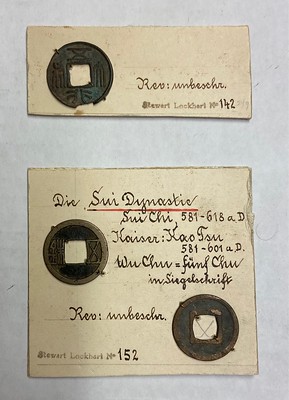 Additionally
the preceding items are accompanied by three small Cash coins,
attributed on cards as Lockhart-142 and 152(2) respectively, avg
VF; mounted onto two possibly reduced size, original Stewart
Lockhart collection cardstock/pages from his personal holdings.
Descriptions in ink and attributions are hand written as made.
Additionally
the preceding items are accompanied by three small Cash coins,
attributed on cards as Lockhart-142 and 152(2) respectively, avg
VF; mounted onto two possibly reduced size, original Stewart
Lockhart collection cardstock/pages from his personal holdings.
Descriptions in ink and attributions are hand written as made.
These items are rarely, if ever available and will likely never
appear again once they go to a new collector home. A once in a
lifetime Holy Grail
type of ensemble for the advanced collector
of Chinese Bronze Cash Coinage that would make excellent
exhibition and educational centerpieces for years to come. Fresh to
the market after decades of storage and worthy of a close review.
Viewing strongly recommended. 6 items. ($1000-1500)
And here's a rare medal in the sale. -Editor
Lot 1539: [Medal] Tsao Kun Silver Medal, ND(1923). P Plain edge. L&M960. AU, expert edge mount removal, retoning nicely from a light old cleaning. Quite attractive and rarely offered. ($2000-2500)
This is a huge sale and Steve and his crew have been running ragged previewing lots for bidders. There are nearly 3,300 lots composed of 250,000-500,000 coins, tens of thousands of tokens and medals, and 50,000-100,000 banknotes. Lots range from $50 to $50,000 with something for virtually every type and level of collector.
To get a feel for the scale, here are some photos of the company offices (and their new mascot Murphy!). -Editor
Steve adds:
"We have sort of had to live at the office as there's too much material to put away each night! It takes four hours to get out and set up and four hours to tear down and put away! To quote one of my fly-in viewers I overheard on a call to someone back in their office:
I am sitting in a freaking warehouse literally filled with coins somewhere in Michigan, you wouldn't believe it!
"
To bid on the live bidding portal, see:
https://numismaticauctions.nextlot.com/public/
For more information, see:
https://numismaticauctionsllc.com/
To read the earlier E-Sylum articles, see:
NUMISMATIC AUCTIONS LLC SALE 66
(https://www.coinbooks.org/v25/esylum_v25n02a18.html)
NUMISMATIC AUCTIONS SALE 66 CONDER TOKENS
(https://www.coinbooks.org/v25/esylum_v25n03a22.html)
NUMISMATIC AUCTIONS SALE 66 SELECTIONS
(https://www.coinbooks.org/v25/esylum_v25n05a20.html)
DIX NOONAN WEBB OFFERS SKIT NOTES
Dix Noonan Webb is offering an interesting group of parody banknotes in their February sale. -Editor
More than 30 ‘skit' notes dating from the 19th century will offered by Dix Noonan Webb in their auction of British, Irish and World Banknotes on Thursday, February 24, 2022 at their Mayfair saleroom (16 Bolton Street, London W1J 8BQ). This group of notes is the first part of the astonishing collection put together by Sir David Kirch - more will appear in future auctions.
As Andrew Pattison, Head of Banknote Department at Dix Noonan Webb, explains: These documents, for it is technically incorrect to call them banknotes, are remarkable pieces of social history. They give us snapshots into the cares, fears, livelihoods, humour and pastimes of those who lived and worked in the British Isles for the last several hundred years.
He continues: Skit notes generally mirror designs of real banknotes of the era. Some, by accident or design, sail very close to the wind, and 19th century court records are full of attempts made by unscrupulous or ignorant individuals to pass them as real money. Many of the punishments were severe, including flogging and transportation to the colonies.
Some of these notes tie in with what we know about the grand story of kings and wars and politics - they warn of imminent French invasion or protest for better working and living conditions. Others are outwardly much more pedestrian, advertising the services of a small wine merchant, or a Christmas pantomime. Still others were never anything more than jokes or amusing gifts for friends or lovers, and are all the more charming for that. Researching skit notes would have been difficult, if not impossible in the days before the internet. Astonishing connections can now be made between the individuals and addresses named on the notes using all sorts of sources such as newspaper articles, court records, maps and ancestry websites. This means that at last, it is possible to tell the hidden stories of these remarkable pieces of paper.
Interesting examples include from Mendham's Tea Warehouse, Ipswich, a note promising to pay the bearer 5 Shillings on demand, hand dated 1803, no serial number or signature, vignette of a tea chest at top left, complete with a naive depictions of Chinese characters which is estimated at £240-£300. William Mendham was born in 1770 in Ipswich. In September 1792 he opened a new grocery and tea warehouse in Bank Buildings, Ipswich. He was quite successful and operated the business for several decades, and married Hannah Baker in 1793 and died in August 1838. The wording on this note is extremely interesting, unequivocally promising to pay the bearer 5 shillings. It is possible it was a real voucher of some kind.
From the Fleet Bank in England, is a 25 Pence note, dated 21 June 1811, with the signature of R. Denton which carries an estimate of £200-£260. Richard Denton was an engraver who appears to have produced these ‘Fleet Bank' notes from his cell in Fleet Prison! When a copper printing plate was discovered in his possession he was sentenced to six more months for the offence. He claimed he was doing it to make ‘a few pence for his family while confined'. This is a very passable imitation of a Bank of England note, the ‘Fleet' part of the title being printed in tiny lettering, and the vignette incredibly similar to that on genuine examples. There are numerous contemporary court cases where people (innocently or otherwise) were imprisoned or even transported for uttering (paying with) these notes.
A superbly engraved £1 note advertising the services of the hairdressing establishment of J. Etches of Nottingham is expected to fetch £200-£260. Jeffrey Etches was born in Nottingham in 1793 and he first appears in the Nottingham Directory as a hairdresser in 1825. He sold his premises on Warser Gate in 1844 and died in 1849. Hairdressers and Barbers of this era often operated as informal agents for servants and employers, hence the text on this note ‘Register Office for Servants'.
A scarce note for the Bank of Elegance, 36 Lowgate, Hull, promising to ‘supply on demand to my friends and the public, Boots and Shoes of the best Quality, at such prices that must give satisfaction, or forfeit the sum of Five Pounds'. Dating from 7 October 1869, it bears the signature of Robert Garton - a successful Yorkshire businessman who appears in records throughout the 19th Century, mostly in Hull. He had various businesses and premises, including one opposite the Hull branch of the Bank of England on Whitefriargate. Despite declaring himself bankrupt twice, in 1850 and 1864, he recovered and left a considerable amount of money when he died in 1898 (est: £150-£200).
Dix Noonan Webb has a strong reputation for selling Irish Banknotes, with one achieving a phenomenal price in the last sale. Another extremely rare specimen note that wasn't circulated will be offered in the February sale. An Irish Free State £100 note, dating from 10 September 1928 – one of only few examples known – is estimated at £12,000-£16,000. While an Irish Free State £50 note from the same date and hand signed by famed Irish statesman Éamon de Valera is expected to fetch £10,000-£12,000. The sale will also include the second part of the collection of the late Gus Mac Amhlaigh of Dublin.
For more information, see:
http://www.dnw.co.uk/
THE BOOK BAZARRE
MAXIMUS WORLD PAPER MONEY COLLECTION
In a February 3, 2022 blog article, Stack's Bowers Paper Money Researcher & Cataloger Chris Dahncke listed some highlights of the Maximus Estate Collection of World Paper Money in their upcoming February world paper sale. Some beautiful notes here. -Editor
Lot 72021: Barbados. Barclays Bank (Dominion, Colonial and Overseas). 100 Dollars, September 1st, 1926. P-S103a. Uncirculated. A cancelled example of this scarce 1926 dated 100 Dollars note (usually cancelled examples are from the 1933 and 1935 series). This example has the Manager's signature, but it is lacking the Accountant's signature.
Lot 72033: Brazil. Republica dos Estados Unidos do Brasil. 1000 Cruzeiros, 1949. P-Unlisted. Front & Back Proofs. Very Fine. Casa da Moeda do Brasil. Appealing front and back proofs of an unprinted 1000 Cruzeiros design.
I've cropped the image to better fit our format - see the complete lot description online (linked in the full article). -Editor
Lot 72054: Cameroon. Kaiserliches Gouvernement von Kamerun. 5 Mark, August 12th, 1914. P-1a. PMG About Uncirculated 50. One of just seven examples graded by PMG for this elusive German Kamerun variety.
A plain Jane, still of historical importance. -Editor
Lot 72112: India. Government of India. 1 Rupee, 1917. P-1c. PMG Very Fine 30. A scarce variety which features the signature of H. Denning. The paper is white which is an anomaly for the assigned grade.
There's a whole sub-specialty of banknotes picturing coins, although most are in the 19th century. What's the most recent dated banknote picturing a coin? Are such notes in circulation somewhere in the world today? -Editor
Lot 72128: Iran. Imperial Bank of Persia. 5 Tomans. 1890-1923. P-3. Remainder. Fine. Printed by BWC. No place name, stamps, signatures, date or serial numbers. An interesting 5 Tomans remainder, the first that we have encountered.
Like a Persian rug! -Editor
Lot 72131: Italian East Africa. Banca d'Italia. 1000 Lire, 14.06/12.09.1938. P-4a. Fine. The colors remain bold, with the design retaining excellent appeal for the assigned condition. Extremely scarce, and sure to attract attention from collectors of Italian and Occupational currency.
Beautiful note. -Editor
Lot 72151: Madagascar. Banque de Madagascar. 20 Francs, ND (1937-1947). P-37. Uncirculated. An exceptionally preserved 20 Francs note. This example appears to be nicer than the note we offered in our April 2021 auction.
The bold yellow color is unusual for a banknote - another pretty piece. -Editor
Lot 72162: Peru. La Republica del Peru. 50 Soles, June 30th, 1879. P-8. Very Good. Dated June 30th, 1879. Incredibly scarce, with few examples found on major third-party grading population reports. Likely missing from even the most advanced collection of Peruvian paper money. We have not offered an example with the signature on the left side of the note before.
There's something to love about even a heavily circulated note like this. A well-executed design, nicely balanced with great details. -Editor
To read the complete article, see:
The Maximus Estate Collection of World Paper Money featured in the February World Paper CCO
(https://www.stacksbowers.com/News/Pages/Blogs.aspx?ArticleID=maximus-collection-paper-money-stacks-bowers-galleries-february-auction)
DAVISSONS ANNOUNCES E-AUCTION 41
Allan Davisson published this announcement of Davisson's Auction 41, which closes March 16th 2022. -Editor
Our annual major sale marks the final result of a year of planning, selecting, acquiring, and soliciting material from this fascinating realm of numismatics. It all comes to a conclusion just as one calendar year ends and another begins. Many of the lots you see in this sale have stories that go beyond the tales the coins or tokens themselves might tell.
The U.S. private territorial gold pieces came from a collection formed over a lifetime by a collector who could get as excited about a beat-up button from the Civil War or an Anglo-Saxon penny. He would usually call after our sales closed and pick up lots that hadn't sold regardless of whether they were the kinds of things he ordinarily collected, as long as they were nice.
Part of the ancient Greek silver offered is from a collection formed by a collector who left behind Spink and Glendining invoices from 1950 and 1951 for a small group of exceptional Greek silver coins. He left behind a sheaf of invoices with a note that these receipts…may not be of interest because they came as lots & too difficult to match with any coins!
I have no idea why the period of enthusiasm and purchasing was as short as it was. What I do realize is that Americans collecting ancient coins in that era was not as widespread in America as it is now.
The ancient section includes a select group of Judaean bronzes. A particularly astute and thoughtful collector put his group together with the help of Brian Kritt, renowned for his own scholarship and the quality of the material he offers. The prutah is a humble coin in terms of its size and its use. We have seen and offered (and have in stock) other examples of this historic coinage, but the quality we are privileged to offer here is mind-boggling.
Just after the ancient section of the catalog and before beginning the British section we have included a few of the delightful Robert Ready British Museum copies of Greek coins. You have seen others before in our catalogs. In the same section is a group of British Museum electrotypes—double thick copies of Anglo-Saxon coins whose purpose seems to have been to provide photographs for the Seaby (now Spink) Standard Catalog of British Coins. I have had these since well back in the last century. I was fascinated when I got them, enjoyed looking at them on occasion but did not really know what they were until I brought them to the office one day late last year and wondered why they were produced and why I had seen almost nothing like them offered over the multiple decades I have been focusing on British coins.
On the topic of things I have happily owned for many years—the collection of Newcastle-on-Tyne patterns were puzzling when I bought the group from a British dealer. Fortunately, the legendary collector Francis Cokayne explained them in tiny notes on a small roundrel that came with the collection. It has been a special experience to own, temporarily (as is true for all of us in this hobby) this small group with a pedigree that goes directly back to the source of the patterns in the first place.
 While we are nearing the end of the exceptional collection of 18th century tokens formed by Michael Sussman, we have had other consignments as well. Most of a small but select collection from another collector is offered here. The quality is exceptional, but a particularly fascinating aspect of the collection is his representation of all but one of the uses of the die for the famed British actor David Garrick. Rated
While we are nearing the end of the exceptional collection of 18th century tokens formed by Michael Sussman, we have had other consignments as well. Most of a small but select collection from another collector is offered here. The quality is exceptional, but a particularly fascinating aspect of the collection is his representation of all but one of the uses of the die for the famed British actor David Garrick. Rated as one of the most talented, convivial, and influential actors of all time…an iconic global thespian
on a website sponsored by the Shakespeare Trust, he was a native of Hereford, partly educated by Samuel Johnson, a would-be lawyer who became a wine merchant before becoming an actor known for introducing realism into his acting. The die is well designed with a high relief that comes through in all the strikes. His popularity seems to have transferred to the use of the die itself because it shows up on ten different tokens in the D&H series, nine of which are represented in this sale.
Finally, the seldom seen and significant—thanks to consignments from collectors who recognize as have I in assembling this catalog that there is time for letting important pieces go to new owners who we hope will enjoy and appreciate them as much as we have in the short time of our stewardship.
There are more special stories in this sale—
- Lot 202: the short-lived 16 shillings of 1581, a superb example of one of the great rarities of the Scottish silver series, a centerpiece from a collector I have known for many years
- Lot 223: unique but not expensive; but what a statement about a birth in 1754, with cheerful looking village scene on the other side
- Lot 302: the massive Birmingham six pence token minted to try to demonstrate that one could produce a token whose copper value reflected its weight
- Lot 327: an amazing overstrike of an 18th century imitative halfpenny on a Middlesex mail coach token
- Lots 329 and 330: rare strikes of non-dimes on silver dime flans, a reflection of our fascination when something supposedly highly reliable goes amuck
There is a subtext here. Over the years I have found myself sometimes putting something I find particularly appealing back. This love for the material is what has driven many years of active work in numismatics. But I too recognize that stewardship is temporary in this area of long preservation. It is time to pass things on to new owners.
Working on this catalog, as always, has been a consuming endeavor for some time. Now it is your turn to see what the three of us have done.
For more information, see:
https://davcoin.com/
NUMISMATIC NUGGETS: FEBRUARY 6, 2022
Here's a selection of interesting or unusual items I came across in the marketplace this week. Tell us what you think of some of these. -Editor
Lot 210. France, Carolingian. Charlemagne (Charles the Great). As Charles I, King of the Franks, A.D. 768-814. AR denier. Class 2. Metallum (Melle) mint, Struck A.D. 771-793/4. Rare.
France, Carolingian. Charlemagne (Charles the Great). As Charles I, King of the Franks, A.D. 768-814. AR denier (18.7 mm, 1.26 g, 7 h). Class 2. Metallum (Melle) mint, Struck A.D. 771-793/4. C(AR)O/LVS in two lines; pellet between / mEDOLVS, short cross over short cross saltire, with annulet in center. Depeyrot 605; MEC 727. Good VF/EF. Rare.
From the upcoming Agora Auctions sale. I don't know why, but the crudeness of this piece is what caught my eye. -Editor
To read the complete lot description, see:
Lot 210. France, Carolingian. Charlemagne (Charles the Great). As Charles I, King of the Franks, A.D. 768-814. AR denier. Class 2. Metallum (Melle) mint, Struck A.D. 771-793/4. Rare.
(https://agoraauctions.com/listing/viewdetail/53765)
7th Massachusetts Civil War Soldier ID Dog Tag. Major General Geo. B. McClellan War Of 1861 Corp. L. Chas. E. Staples Co. C 7th Mass. Vols. Batt. Wmsburgh, Fairoaks, 7 Dys At Richmond, Antietam, Fdksburgh, Chancellors Ville & Gettysburgh.
Great item! What a war career! From the eBay sales of Steve Hayden. -Editor
To read the complete lot description, see:
7th Massachusetts Civil War Soldier ID Dog Tag Gettysburg Prisoner Of War POW
(https://www.ebay.com/itm/224810235224)
FRANCE. Public Education Ministry Award Gold Medal, 1879. NGC MS-62.
By Vauthier Galle. Diameter: 46 mm. Weight: 71.35 gms. Obverse: Head of Ceres left, crowned by floral wreath; Reverse: Encircling inscription reading: MINISTERE DE L'INSTRUCTION PUBLIQUE DES CULTES ET DES BEAUX-ARTS [MINISTRY OF PUBLIC INSTRUCTION OF CULTURE AND FINE ARTS]; within, 10 line inscription: CONCOURS DE 1879 / Mr. SCHRADER MEMBRRE DE LA SOCIETE RAMOND A BORDEAUX / RECHERCHES SUR LES PYRENEES [COMPETITION OF 1879 / Mr. SCHRADER MEMBER OF THE RAMOND COMPANY IN BORDEAUX / RESEARCH ON THE PYRENEES]; Edge: "E:BEE".
A phenomenal and generously sized medal in gold struck to commemorate achievement in the arts and sciences of the highest caliber. Awarded to Franz Schrader, who was a French geographer and cartographer. Schrader's research on the Pyrenes was considered pioneering, and his plans to create a general map of the Pyrenees in 1879 led to his award of a grant from the Ministere de L' Instruction to do so. This ambitious goal and grant likely accounts for the awarding of this medal, as Schrader was the winner in the competition for funding.
From the Stack's Bowers February 2022 World Collectors Choice Online Auction. -Editor
To read the complete lot description, see:
FRANCE. Public Education Ministry Award Gold Medal, 1879. NGC MS-62.
(https://auctions.stacksbowers.com/lots/view/3-VAMVK/france-public-education-ministry-award-gold-medal-1879-ngc-ms-62)
1929 Congressional Gold Medal for the Conquest of Yellow Fever. Awarded to John Kissinger. In 1900, Kissinger was the FIRST person to step up and volunteer to be infected in order for his commanding officer, Dr. Walter Reed, to test and confirm his working theory of how the deadly disease was spread. Reed later wrote that in his opinion, Kissingers exhibition of moral courage has never been surpassed in the annals of the Army of the United States. The Congressional Gold Medal is the highest civilian honor bestowed by the government, equal to the Congressional Medal of Honor and the Presidential Medal of Freedom, but far less frequently awarded.
The medal, awarded by an act of Congress, has been given out only 173 times, versus 647 Presidential Medals of Freedom. Each Congressional Gold Medal is created by the U.S Mint, and its design is unique to the honor bestowed on the recipient. This medal is struck in .999 solid gold (XRF tested), measures 2-1/2" diameter, and weighs 6.2 Troy ounces. Comes with original leather presentation box with Kissinger's name embossed on it, as well as the original 1933 award banquet program. The historical importance of this collection can hardly be overstated. Also in this auction are several other pieces from Kissinger's estate related to the fight against yellow fever. Provenance: The entire collection offered here (lots 150 through 156) was obtained decades ago directly from the family of John Kissinger and has been in the same hands since then.
The French medal is nice, but THIS is an important medal. Offered by Blackwell Auctions LLC on February 12, 2022. -Editor
To read the complete lot description, see:
Lot 150: CONGRESSIONAL GOLD MEDAL Yellow Fever
(https://www.invaluable.com/auction-lot/congressional-gold-medal-yellow-fever-150-c-1AD4C3B978)
LATE ROMAN DIG YIELDS 1,200 COINS
They lost their heads, but not their pocket change. Arthur Shippee passed along this BBC News article that discusses Iron-Age coins found during the excavation of a late Roman town and cemetery. Thanks. A team of 50 archaeologists worked on the site for more than a year. -Editor
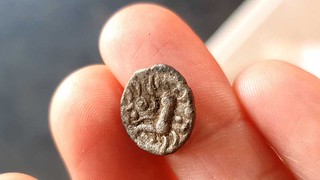 Decapitated skeletons, brooches, spoons, coins and tableware have been found in an archaeological dig that uncovered part of a Roman town.
Decapitated skeletons, brooches, spoons, coins and tableware have been found in an archaeological dig that uncovered part of a Roman town.
This included the largest Roman cemetery yet to be excavated in Buckinghamshire, with 425 burials.
Several lead weights and more than 1,200 coins were discovered, suggesting the site was used for trade and as a staging post for travellers and soldiers passing along the road to the garrison at Alchester.
Many domestic finds were made, including gaming dice, bells and jars, while a stone-built corn dryer or malting oven provided evidence of brewing.
High quality tableware called Samian pottery and spoons, pins and brooches were also unearthed.
About 10% of those buried in the late Roman cemetery were decapitated, which could be a "normal, albeit marginal, burial rite" - or an indication those decapitated were criminals or outcasts.
Check out the full article online for cool images of the artifacts and spooky skeletons. Love the iron-age dice. -Editor
To read the complete article, see:
HS2: Decapitated skeletons found near Aylesbury
(https://www.bbc.com/news/uk-england-beds-bucks-herts-60254154)
U.S. MINT MANUFACTURING COSTS REPORTED
The U.S. Mint recently published its 2021 Annual Report. Mike Unser summarized manufacturing costs in a CoinNews.net article. Here's an excerpt - see the complete article online. The one and five cent coins continue to cost more than face value to produce, but seigniorage totaled $381.20 million for the fiscal year that began on October 1, 2020 and ended on September 30, 2021. -Editor
 The price for manufacturing U.S. coins for circulation went up last year, except for the half dollar, the United States Mint disclosed this month in its 2021 Annual Report. And for a sixteenth straight year, the unit cost for both cents and nickels was above their face values.
The price for manufacturing U.S. coins for circulation went up last year, except for the half dollar, the United States Mint disclosed this month in its 2021 Annual Report. And for a sixteenth straight year, the unit cost for both cents and nickels was above their face values.
The Mint struck nearly 15 billion coins for circulation during the fiscal year.
In FY 2021, the toll to make, administer and distribute the 1-cent coin climbed to 2.1 cents from 1.76 cents while the cost for the 5-cent coin increased to 8.52 cents from 7.42 cents. Higher prices for copper and zinc accounted for much of the increases.
Lincoln cents have a composition of 2.5% copper with the balance zinc. Five-cent coins are minted in 25% nickel with the balance copper. Dimes, quarters, and half dollars are each composed in 8.33% nickel with their balance copper.
Unlike for cents and nickels, the U.S. Mint made money in striking dimes, quarters, and half dollars because the cost of manufacturing and distributing them was lower than their face values.
In FY2021, the unit cost for the quarter increased to 9.63 cents from 8.62 cents and the dime's unit cost rose to 4.39 cents from 3.73 cents. The unit cost for the half dollar, meanwhile, decreased to 11.67 cents from 25 cents — supported by an increase in the number of half dollars made and shipped to Federal Reserve Banks.
To read the complete article, see:
Penny Costs 2.1 Cents to Make in 2021, Nickel Costs 8.52 Cents; US Mint Realizes $381.2M in Seigniorage
(https://www.coinnews.net/2022/01/18/penny-costs-2-1-cents-to-make-in-2021-nickel-costs-8-52-cents-us-mint-realizes-381-2m-in-seigniorage/)
THE COIN ANALYST ON THE 2021 MINT REPORT
A more comprehensive analysis of the 2021 U.S. Mint Report comes from Louis Golino "The Coin Analyst" at CoinWeek. This is just an excerpt related to the cent - be sure to read the complete article online. -Editor
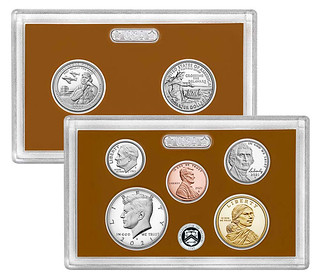 While the Mint managed to generate seigniorage and net income from all coins that totaled $556.4 million (including $381.20 million
from circulating coins), this represented a decrease of 30% compared to the prior year.
While the Mint managed to generate seigniorage and net income from all coins that totaled $556.4 million (including $381.20 million
from circulating coins), this represented a decrease of 30% compared to the prior year.
The main reason for that is that the cost to produce the cent rose to 2.1 cents and the nickel to 8.52 cents from 1.76 and 7.42 cents respectively the prior year due to rising zinc and copper costs. In addition, shipments of pennies and quarter dollars decreased during this period.
Despite ongoing calls to follow most other countries and eliminate the one-cent coin, there are no plans to do that in the U.S. or to cease production of nickels–neither of which has much purchasing power today. The reason for this situation remains unclear but may be related to sentimental attachment to the Lincoln penny and opposition from some to rounding transactions up or down as would be required if those coins were eliminated. Others claim that the zinc industry opposes the move (cents are mostly made of zinc today). Besides, if we only get rid of the penny, that means making more nickels, which would still be produced at a loss. If it were up to your columnist, we'd just make both coins for collectors.
In addition, the United States Mint continues to explore the possibility of making those coins from alternative metals or even plastic (as it has since the 1974 aluminum cent), but so far no solution has been found that would substantially decrease total costs.
NOTE: Louis provided an update to the article's first sentence to clarify the components of seigniorage and net income. The CoinWeek version may not yet have this revision, but it should be on the way. -Editor
To read the complete article, see:
The Coin Analyst: 2021 Was a Banner Year for the United States Mint
(https://coinweek.com/us-mint-news/the-coin-analyst-2021-was-a-banner-year-for-the-united-states-mint/)
HOW THE MINT DECIDES HOW MANY COINS TO MAKE
On a related note, public radio's Marketplace took a look at how the Mint decides how many coins to produce each year. Here's an excerpt - see the complete article online. -Editor
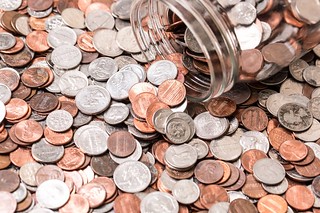 Listener and reader Jeff Bailey from Jonesboro, Arkansas, asked:
Listener and reader Jeff Bailey from Jonesboro, Arkansas, asked:
I've noticed that the mint numbers for coins can vary a lot from year to year. How does the United States Mint determine how many coins of each denomination to produce in a year?
In 2021, nearly 15 billion pennies, quarters, nickels, dimes and half dollars departed the U.S. Mint's facilities to be spent by the public.
Like Bailey pointed out, it's a figure that can fluctuate annually. In 2019, roughly 12 billion of these coins were produced.
To determine how many coins the mint should produce, the Federal Reserve devises a 12-month rolling forecast, according to the U.S. Mint's website. The Federal Reserve also gives the mint monthly coin orders.
The U.S. Mint uses this forecast to determine how much of each denomination it'll produce, then it makes the coins and transports them to the Federal Reserve banks and private-sector coin terminals.
The Fed banks then deliver the coins to depository institutions, which exchanges them with their customers. And that is how the circulation cycle begins.
Behavioral patterns, long-term demand, holidays, unforeseen events like natural disasters and a pandemic can all play a role in how many coins are manufactured.
Daniel Soques, an assistant professor of economics at the University of North Carolina Wilmington, said natural disasters increase the demand for cash and coins because disasters often disrupt electronic payment systems.
Soques noted that before 2009, each of the 12 Federal Reserve banks determined the need for coins on an independent basis and submitted those orders to the U.S. Mint.
This process was relatively inefficient, so the process is now centralized at the Fed's Cash Product Office,
he said.
Assessing how many coins to produce is a lot different than figuring out the production of, say, crockpots, Soques explained.
They present a special problem because you have the other side of it, where they get reused,
he said.
The Fed's Cash Product Office assesses the inventory at the Fed's roughly 200 coin vaults throughout the U.S. on a daily basis, he added.
The Fed wants a minimum inventory level of two weeks' worth of coins at each coin vault. So the CPO will move coins from one coin vault to another to make sure this happens,
Soques said. If there aren't enough coins across all the coin vaults to meet demand, then the CPO will put an order for new coins into the mint.
Todd Martin, deputy chief of corporate communications at the U.S. Mint, said in an email that coins aren't circulating through the economy as quickly as we need them to, which means that sometimes coins are not readily available where they are needed.
To read the complete article, see:
How does the U.S. Mint decide how many coins to produce each year?
(https://www.marketplace.org/2022/01/27/how-does-the-u-s-mint-decide-how-many-coins-to-produce-each-year/)
MARTIN LUTHER KING, JR. MEDALLIONS
In recent years John Kraljevich has written on Facebook about various aspects of African-American history for Black History Month, usually in connection with a numismatic object. On February 1st he announced that he's working to pull these stories together into a book due to be published by Whitman Publishing later this year, titled Freedom Will Be Ours. We'll look forward to it!
Yesterday's post discussed Martin Luther King, Jr. medallions. Here's an excerpt - see the complete post online. -Editor
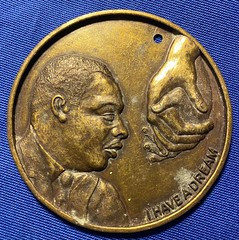 For those who wanted to show their loyalty to the ideals of Martin Luther King, Jr., or who wanted to make plain their part in his legacy, a portrait medallion of King was a natural accessory. Most types I've seen show his portrait in profile or three-quarter profile, often with an inscription noting the dates of his birth and death.
For those who wanted to show their loyalty to the ideals of Martin Luther King, Jr., or who wanted to make plain their part in his legacy, a portrait medallion of King was a natural accessory. Most types I've seen show his portrait in profile or three-quarter profile, often with an inscription noting the dates of his birth and death.
Jackson's Martin Luther King medallion seems to have showed up in 1970. His was especially large, nearly four inches in diameter. It showed a very high relief portrait of King facing left and was suspended from a substantial chain with two hangers. The earliest appearance of it I've found was published in the October, 17, 1970 issue of the Wilmington News Journal during a visit to Delaware for an NAACP convention. He wore it on the cover of the September 23, 1971 issue of Jet magazine and at the opening of the Black Expo in Chicago the same week. Perhaps most famously, Jackson wore it on Sesame Street's Episode 402, recorded on February 23, 1972 and on August 20, 1972 at the Los Angeles Memorial Coliseum for the Wattstax benefit concert, before a crowd of 112,000. Millions more saw it when the Wattstax movie saw wide release.
After a handful of appearances in 1973, including at the Operation PUSH convention in June of that year, Jackson seems to have mostly retired his MLK medallion. Fashion changed, and Jackson changed with it.
But the day Jackson put his MLK medallion back in his jewelry box was far from the end of the King medallion.
Interestingly enough, Hosea Williams made more news with Martin Luther King medallions than Jesse Jackson ever did.
Williams' medals first hit the newspapers late in 1968. The earliest advertisement I've found was from the December 7, 1968 issue of The Pittsburgh Courier, an African-American weekly newspaper. Official MARTIN LUTHER KING Medallion,
the ad read, calling the piece a magnificently sculptured, heavy metal medallion of Martin Luther King.
It was available mounted on a plaque or on a handsome black-finish chain for neckwear.
Williams later stated he had 20,000 of the medals created as an SCLC fundraiser at a cost of 30 cents each. It's not clear how much of the $4.95 sale price went to the organization, but the advertisement did note that the medal was authorized by the SOUTHERN CHRISTIAN LEADERSHIP CONFERENCE, which receives a share of the revenue.
The three-inch medallions depicted King, in a profile facing right, looking at two large and out of scale holding hands with the inscription I HAVE A DREAM along the lower right border.
An April 9, 1969 article in the Charlotte Observer about a clash between militant and peaceful protestors in Hickory, North Carolina described Golden Frinks, the field secretary for the North Carolina chapter of the SCLC, wearing a brass medallion dangling from his neck [that] portrayed Martin Luther King and bore the inscription ‘I have a dream.'
A photograph of Sala Udin, the Pittsburgh civil rights leader, depicts him wearing one while sitting next to Ralph Abernathy in August 1973.
The market for King medals appeared rather immediately after his assassination. Under a headline proclaiming Assassination Souvenirs Become Big Business,
the August 20, 1968 issue of The Daily Oklahoman reported that one Washington business venture, operated and managed by Negroes, capitalizes on the sale of medallions of Dr. Martin Luther King, Jr. to assist Negro artists and to provide jobs for other Negroes, including salesmen.
While many different medals and wearable medallions were created, the SCLC-sponsored medallion seems to have been the only one with a claim of officialdom.
To read the complete post, see:
The men who became the leaders of the next generation were in Memphis that day.
(https://www.facebook.com/john.kraljevich/posts/10228503097262260)
THE DRESS MADE FROM PENNIES
Dresses made of meat are sooo 2010... Today's fashion choice is a dress made from coins. -Editor
Mike Nixon of Pearland, TX writes:
"My wife inhabits a whole ‘nuther part of the internet universe than I do…she came across this and sent it to me, I found it interesting and thought the E-Sylum audience would too. The video of the young lady describing how she did it and the sheer amount of work it took is entertaining."
While some may choose to put their change in a piggy bank, others use it as the material for marvelous creations. Artist Shay Rose (aka Crescent Shay) used over 2,000 pennies in her latest handmade garment: a shimmering cocktail dress with cross-back straps and a bottom fringe.
 The 22-year-old maker is well-known on social media for her imaginative projects (including her transformative green screen dress). For this endeavor, Shay collected hundreds of pennies, which she then cleaned thoroughly, and drilled holes in along the sides. This allowed her to sew these copper pieces together and create the bodice and skirt of the dress.
The 22-year-old maker is well-known on social media for her imaginative projects (including her transformative green screen dress). For this endeavor, Shay collected hundreds of pennies, which she then cleaned thoroughly, and drilled holes in along the sides. This allowed her to sew these copper pieces together and create the bodice and skirt of the dress.
Shay modeled the completed dress in her Instagram photos, showing off the lustrous effect of the coins in sunlight. From far away, the 2,652 pennies blend together to create a sequined effect. However, when you look at the frock up close you can admire the meticulous detail Shay put into weaving all of the coins together in a neat chainmail pattern. The statement dress could easily pass as a 1920s-era costume from The Great Gatsby.
Nice, but how much does that WEIGH? Will we see one at the next ANS Gala? Or walking the floor at the ANA? -Editor
Mike adds:
"She mentions how heavy it is in the video, says she thinks it must weigh 10 pounds, and that she had to re-do the straps with fishing line because they broke when just using thread. Do the math at 2.5 g per coin and it comes to 14.6 pounds. She also shows that wearing it for the time it took to take the photos left red marks on her shoulders."
Perfect for a mannequin at the ANA museum! -Editor
To read the complete article, see:
Iridescent Cocktail Dress Is Handmade From Over 2,000 Pennies
(https://mymodernmet.com/crescent-shay-dress-made-of-pennies/)
THE NEW YORK GOLD CUBE NFT PROMOTION
Michael Kodysz writes:
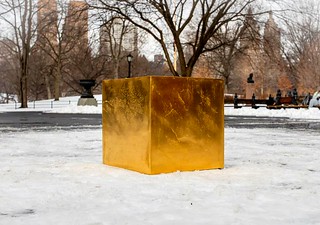 "I heard on Good Morning America that a German artist named Niclas Castello dropped a
"I heard on Good Morning America that a German artist named Niclas Castello dropped a solid gold cube
worth $11.7 million in Central Park. My first thought: a 24kt-solid-gold cube that size would be worth a lot more than $11.7 million, and too heavy to transport or move without heavy-duty equipment. I doubt that a single artist or even a single corporation could get their hands on that much gold all at once. I told my wife, I bet it's hollow
and sure enough it is. To describe the cube as solid gold
is as misleading as claiming that a hollow Easter bunny is made from solid chocolate. It isn't.
"An interesting exercise: calculate the weight and value of the 24kt-gold cube if it were actually solid rather than hollow. Judging by the photos I'm guessing the cube's size at around 24-inches square.
"This story is on numerous news outlets."
Thanks. I had similar thoughts when I saw this. Numismatists are no dummies - gold is really, really dense and heavy. That's a very misleading photo - the photographer must have been laying on their stomach to get the shot of the lilliputian-sized "This is Spin¨al Tap" Stonehenge-style monument. Here's an excerpt from The New York Times about this Instagram bait and NFT promotion. -Editor
The fun thing about conceptual art is that it's totally easy to create. You can say something about the increasingly virtual way many of us experience the world, and the explosive popularity of NFTs (nonfungible tokens) — or seem to say something profound, anyway — just by staging a Central Park happening around a knee-high cube of 24-karat gold.
At least, that's what the German pop artist Niclas Castello has done. His Castello Cube,
cast from more than 400 pounds of Nevadan gold, appeared in a patch of icy slush opposite the Naumburg Bandshell on Wednesday, preceded by an over-the-top marketing campaign that included a wraparound ad in that morning's edition of The New York Times. Related NFTs from the artist and even a new digital currency, Castello Coin, will drop later in the month. The artist did privately presell enough of the coins to finance this project, according to Marina Dertnig, a member of the production team. The cube is not solid all the way through: it has a hollow core. But the gold alone is worth more than $10 million at current prices.
When I visited, the cube was surrounded by a steady trickle of gawkers, some of whom had come to see the art and others drawn by the crowd itself. I love a group of people staring at a box,
said Isabel Robin, an actor and tour guide.
After all, the last time New Yorkers got to see such a sizable chunk of gold in public was in 2016-2017, when Maurizio Cattelan installed his 18-karat gold toilet, America,
at the Guggenheim Museum.
What the Castello Cube
really speaks to is the self-sustaining power of capital. If you have the resources to get hold of $10 or $11 million dollars' worth of gold from a UBS Bank in Switzerland — as Castello did — and then pay a centuries-old bell foundry there to shape it into a cube, and finally to ship this cube to the most visible park in the finance capital of the Western world, you can get people to look at it, talk about it and review it — and then, in what is shaping up to be the new gold standard, sell the whole experience as an NFT.
"When I saw a photo of the cube on TV it looked huge, and they said solid gold!
I read somewhere that the total amount of gold ever mined in the world would fit inside of an Olympic-size swimming pool. I found a graphic that illustrates this, although the giant cube of gold shown in the graphic is multiple times deeper/higher than the pool."
To read the complete article, see:
It's Gold, Baby. But Niclas Castello's Cube Is Nothing New in Art.
(https://www.nytimes.com/2022/02/02/arts/design/gold-cube-niclas-castello.html)
And another story on Mashable:
That viral gold cube is actually pretty small. Oh, and it's hollow.
(https://sea.mashable.com/life/19192/that-viral-gold-cube-is-actually-pretty-small-oh-and-its-hollow)
And the infographic:
If all the gold ever mined was melted into one solid cube, this is how big it would be
(https://imgur.com/5Wfwk7f)
LOOSE CHANGE: FEBRUARY 6, 2022
Here are some additional items in the media this week that may be of interest. -Editor
In a blog article, JP Koning discusses why those Henry III gold pennies are so rare. Found via News & Notes from the Society of Paper Money Collectors (Volume VII, Number 33, February 1, 2022) -Editor
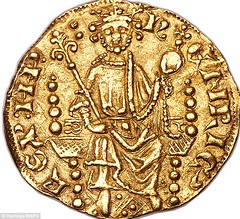 Minted in 1257, only eight of Henry III's gold pennies have survived. This is odd given that medieval historian David Carpenter's analysis of historical records indicates that 72,000 of these coins may have been produced within a year or two.
Minted in 1257, only eight of Henry III's gold pennies have survived. This is odd given that medieval historian David Carpenter's analysis of historical records indicates that 72,000 of these coins may have been produced within a year or two.
Why are there so few of Henry III's gold pennies still in existence? In this short post I'll suggest that the gold penny was a failure. Rather than circulating in trade, as one would expect of a coin, most of them were melted down within a year or two after issuance. And so there are very few gold pennies left for detectorists to find.
In his paper Gold and Gold Coins in England in the Mid-thirteenth Century, Carpenter maintains that Henry III picked the right ratio between gold pennies and silver pennies. A gold penny weighed the same as two silver pennies. At Henry III's chosen exchange rate of twenty silver pennies to one gold penny, this implied a price of ten grams of silver to one gram of gold. Carpenter says that this was in line with the prevailing 10:1 market rate between silver and gold bullion at the time.
But historian John Munro suggests otherwise. What Carpenter omits is that an English silver penny was only 92.5% pure, the remaining 7.5% being comprised of base metals. This means that Henry III's chosen exchange rate of twenty silver pennies to one gold penny actually valued the quantity of gold inside a gold penny at just 9.3 times that of an equivalent amount of silver, not 10 times.
Thus the king's chosen rate undervalued gold. And so Henry III's gold penny would have run smack dab into Gresham's law. It would have been more profitable for an English merchant to melt down 1 kg of gold pennies into bullion and buy 10 kg of silver with the proceeds at the going market rate than to spend that 1 kg of gold pennies as coins...
To read the complete article, see:
Why Henry III's gold penny failed
(http://jpkoning.blogspot.com/2022/01/why-henry-iiis-gold-penny-failed.html)
To read an earlier E-Sylum article, see:
ARTICLES HIGHLIGHT HENRY III GOLD PENNY
(https://www.coinbooks.org/v20/esylum_v20n54a27.html)
Pablo Hoffman passed along this National Public Radio story about digital cash and central bank digital currencies. -Editor
 The U.S. is gingerly considering whether to adopt a digital version of its currency, one better suited for today's increasingly cashless world, ushering in what could be one of the dollar's most fundamental transformations.
The U.S. is gingerly considering whether to adopt a digital version of its currency, one better suited for today's increasingly cashless world, ushering in what could be one of the dollar's most fundamental transformations.
In that scenario, the U.S. would not only mint the coins and print paper bills. It would also issue digital cash, or a central bank digital currency (CBDC), that would be stored in apps or "digital wallets" on our smartphones.
It's a vision of a cashless future that other countries are already embracing. China, for example, has already unveiled the digital yuan on a trial basis. India this week said it would also unveil a digital rupee.
Now the U.S. is weighing whether it wants to get into the game.
To read the complete article, see:
The U.S. is considering a radical rethinking of the dollar for today's digital world
(https://www.npr.org/2022/02/06/1072406109/digital-dollar-federal-reserve-apple-pay-venmo-cbdc)
The January 3rd, 2020 cartoon from The New Yorker. -Editor
To read the complete article, see:
Daily Cartoon: Monday, January 3rd
(https://www.newyorker.com/cartoons/daily-cartoon/daily-cartoon-monday-january-3rd)

